
Wood hangboards are the best: versatile, smooth, and they force you to use pure finger strength—which, after all, is the point.
The post Weak Fingers? Check Out Our Favorite Hangboards, Field-Tested. appeared first on Climbing.
]]>
I was up in the Flatirons, Colorado, recently with my buddy Andy, belaying him on the legendary sport route Slave to the Rhythm (a nod to the Grace Jones album). We chatted between burns about the route’s history, including how the first ascensionist, Dan Michael, gave all the extruded cobbles funny names—e.g., “the Skinhead”—and nailed a piece of wood to a tree to warm up on. Back in 1987, this was visionary stuff: Previously, we had this bizarre idea that you should just show up to your project and give a burn while your muscles were still “fresh,” and so barely warmed up properly.
In that benighted era, training and logistics lagged well behind physical strength; at-home hangboards were sharp, tweaky, and rudimentary; and “portable hangboards” were, apparently, strips of wood nailed to trees.
We’ve come a long way into today’s world of doorjamb-mounters, sculpted resin hangboards, and wooden apparati. For my money, the wood hangboards are the best: versatile and smooth, they’re ideal both to warm up on and at the session’s end, when skin is thin. And they force you, by relying less on friction, to use pure finger strength—which, after all, is the point.
There are lots of wooden options. The four below are my favorites, both at the crag and in the gym/home during training cycles.
Beastmaker 1000 Series

This is the kindler, gentler hangboard from the UK-based wooden holds and hangboard maker Beastmaker, with the 2000 having gained a cult following among training cognoscenti for its sloping monodoigts and one-arm deadhang/pull-up benchmark “middle edge.” The 1000 has no monos—which, frankly, with sausage-sized, tweak-prone middle fingers I don’t miss—but instead a series of slots/pockets from four fingers down to two, and from “very deep” (~40 mm) to “small” (10 mm), as well two handlebar jugs and two pairs of slopers. The 1000 Series brushes clean with little effort and has a grippy, tight-grained texture, making it a go-to for volume sessions including drills like repeaters.
Pros
- Rounded pocket shapes are kind on sore joints and trashed skin, as well as “open” enough to allow for full and half crimping
- Jugs are of a comfortable size and perfect width for pull-up and lower-out workouts
- Amazing texture
Cons
- The 20-degree slopers are plenty usable, but the 35-degree slopers may be too aggressive on dry-skin days (wet your hands with a spray bottle first)
- You can “cheat” by pressing your fingers against the sides of the relatively tight slots to increase holding power
Metolius Climbing Nano Rings

The aptly named Nano Rings are so small it’s ingenious how many grips—eight, from 40 mm down to 10 mm—Metolius has loaded into such a small package, one roughly the size of two protein bars. This has made them a go-to for crags with long approaches, where I’m paring down my pack to the minimum, such as on a local Flatirons project with a one-hour, 1,000-foot-vertical-gain approach. Usually I just “make the rounds,” starting with the jugs and working my way down the crimp ladder till I can recruit on the 10 mm slimpers. The wood is cool and soft on the skin, and the Rings are so thin (1.6”) that you can full-squeeze/pinch the crimps to warm up your drag.
Pros
- Extremely compact (5” x 3”), light (7.7 oz), and portable, but still has six edges in 5 mm increments from 25 mm to 10 mm, plus a 40 mm full-hand and 40 mm fingertip jug
- Smooth, friendly texture that holds chalk well
- Affordable
Cons
- Holds can only be used in one orientation—the “incut” one (though there are sloping 10 mm edges inside the cutouts)
- Website says “body weight only,” meaning no weighted pull-ups
Tension Climbing The Block (aka Tension Blocks)
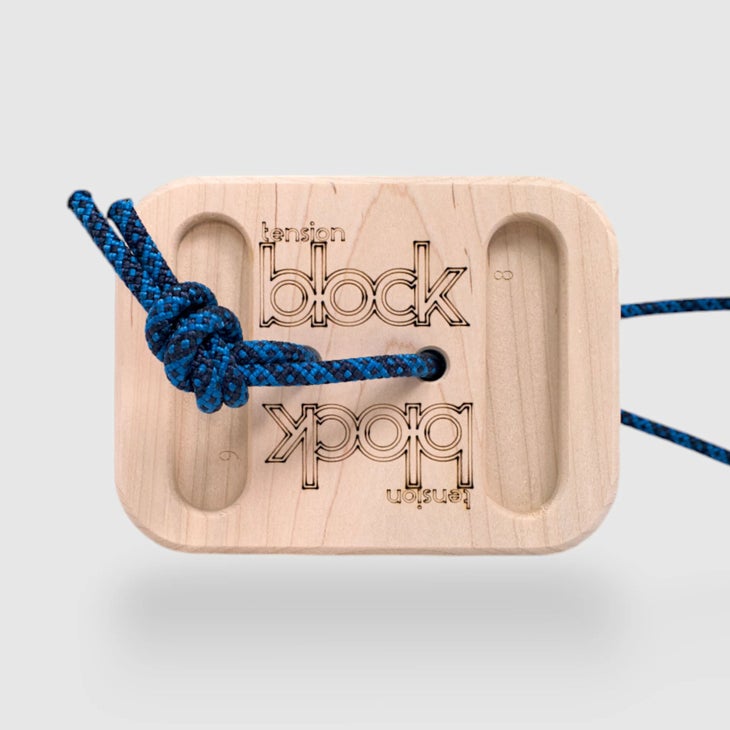
When Tension Blocks came out in 2019, they were so novel I didn’t understand them—did you hang them from a tree branch and do pull-ups/deadhangs for a cliffside warm-up? Clip a draw to the keeper loop and stand on it, to pull against the crimps and fire up your digits? Use them to lift weights off the floor to do “max hangs,” or perhaps lat pulls on a cable machine? Well, it turns out, all of the above, which is what makes these little (4”x6”) chunks of wood so cool. I’ve had mine for a few years, and one lives at the cliff for warming up or I use a pair for max hangs. There are crimps from 20 mm to 6 mm, pinch possibilities, a 25 mm bidoigt, and a 25 mm monodoigt—i.e., plenty of versatility.
Pros
- You can flip the keeper loop, varying the angle of attack to make the holds either “incut” or “sloping”
- Smooth texture and big, rounded radius on crimps makes for comfortable recruitment
- Portable and versatile
Cons
- Monodoigt could be deeper, to avoid risk of tweakage (or just make another bidoigt!)
- Wood is soft, so care must be taken with storage, transport, etc. to avoid dings and splinters
Tension Climbing Whetstone
 As with Beastmaker, Tension also sells multiple tiers of hangboards: the advanced/elite Grindstone and the friendlier Whetstone, which has two ergonomic jugs with bumps to displace weight, big (40 mm) bidoigts and edges, mid-sized crimps (25 and 30 mm), benchmark 20 mm edges (the gold standard for weighted/max hangs), and a 40 mm “one-arm” slot/edge right in the middle. My local training facility The Campus has a row of alternating Whetstones and Grindstones; the two boards complement each other well, giving you a range of holds from 40 mm down to 8 mm. Both boards are also near-frictionless, making you train with power and focus. Read our full review of the Whetstone here.
As with Beastmaker, Tension also sells multiple tiers of hangboards: the advanced/elite Grindstone and the friendlier Whetstone, which has two ergonomic jugs with bumps to displace weight, big (40 mm) bidoigts and edges, mid-sized crimps (25 and 30 mm), benchmark 20 mm edges (the gold standard for weighted/max hangs), and a 40 mm “one-arm” slot/edge right in the middle. My local training facility The Campus has a row of alternating Whetstones and Grindstones; the two boards complement each other well, giving you a range of holds from 40 mm down to 8 mm. Both boards are also near-frictionless, making you train with power and focus. Read our full review of the Whetstone here.Pros
- The deep two-finger pockets and ergo-bump jugs are kind on the tendons, even when doing weighted lower-outs and pull-ups on the jugs
- Mid-sized edges are well-milled, with a broad radius that lets you push max hangs—failure is gradual, not sudden
- Lots of holds in a compact package—jack-of-all-trades space-saver
Cons
- One-arm progression is limited by the jump from the 40 mm central slot down to the 30 mm edges (i.e., there’s no 35 mm option)
- Minimal overhang between rows means you can “cheat” your thumb on the lower row while dangling from the upper edges
The post Weak Fingers? Check Out Our Favorite Hangboards, Field-Tested. appeared first on Climbing.
]]>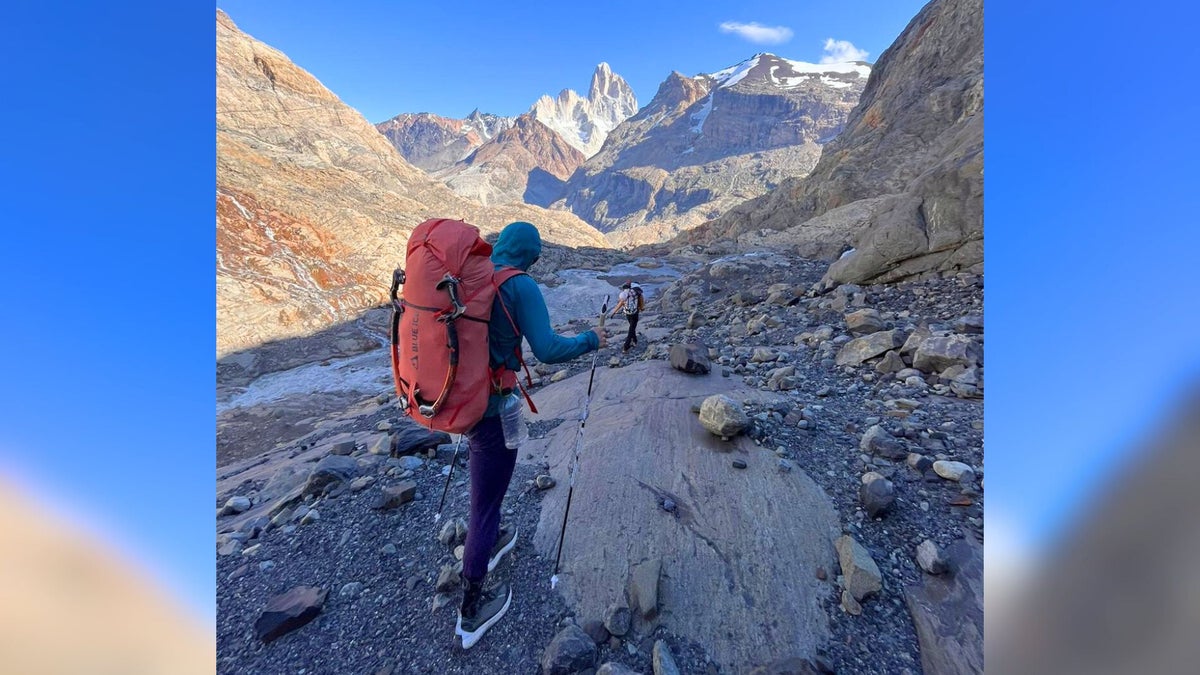
Poles may save your knees, but at what expense?
The post The Weird, Very Real Danger of Approaching Climbs With Poles appeared first on Climbing.
]]>
Anyone who hates hiking knows poles are your best friend. They can support part of your bodyweight to reduce the strain on your tired glutes and quads, they can stop you from keeling over when your pack feels like it’s equal to your bodyweight, and they can provide stability when teetering over loose rock. But poles can also break your bones. No, not from a fall—I broke my hand without ever hitting the ground.
How the injury happened
Washington Pass is a spectacular climbing area: it’s technically roadside, it’s not too crowded, and there are mountain goats everywhere. Unfortunately, depending on what climb you’re aiming for, you might be hiking anywhere from two to five hours a day to reach and return from your climb. The approaches range from decent single-track trails to steep, sandy talus.
On a particularly steamy summer’s day, my partner and I decided to climb Free Mojo (5.11; 800ft) on the South Early Winters Spire. It took us about an hour and a half to get to the base, and another hour and a half to hike back to the parking lot. I was using Black Diamond Distance Carbon FLZ poles—my favorite due to their light weight and three-part packability.
But that evening, when I got back to the car, I couldn’t move my left pinky finger. Maybe a weird cramp? A mild sprain? Was I just tired? By the next morning, the pain had surged throughout my hand, radiating into multiple fingers. Something was definitely wrong.

I rested my hand for a few weeks but saw no improvement. A physiotherapist assessed the damage, needled my hand (to promote relaxation and increase blood flow), and then sent me off with tape and more rest. Six weeks in, the pain hadn’t let up, so I called in reinforcements: Dr. Andrew Reed, a sports medicine physician at Banff Sports Medicine. He is also one of the more impressive endurance athletes in the Canadian Rocky Mountains, and a coach with Evoke Endurance. A quick Google search revealed he is also the lead team physician for the Canadian National Biathlon and ParaNordic ski teams. Surely he would know what was wrong with me.
Dr. Reed X-rayed my hand, assessed my wrist’s movement and associated pain patterns, and delivered his verdict: a possible hamate fracture and a sprained carpal ligament—likely the result of gripping and weighting my pole for multiple hours in Washington Pass, day after day.
Turns out, I wasn’t alone. Swapping injury stories with Brette Harrington, I learned that Marc-André Leclerc was sidelined for weeks due to a similar mechanism of injury, his forearm wrecked from constant pole use in Patagonia’s Torre Valley. Another friend of mine, who is a ski guide with the Association of Canadian Mountain Guides, had a wrist stress fracture after a winter’s worth of deep trail breaking in British Columbia’s Selkirk mountains. The more I asked around, the more I learned about pole-induced injuries.
How climbers can reduce trekking pole injuries
So if trekking poles can prevent us from climbing at all, what are backcountry climbers supposed to do—ditch poles entirely? My quads would stage a mutiny before I even left the parking lot. I started to pay attention to what poles endurance athletes were using on social media. Leki poles were particularly interesting: their “Trigger System” uses a breathable mesh that wraps around the meat of your hand, like a triangular fingerless glove, and ensures the impact of your poles, and your weight, is distributed evenly, reducing the risk of injury. The repeated, forceful pressure we put on our poles could perhaps be avoided with this technology.
Watch Emilie test the Leki CrossTrail FX One Superlite pole in Idaho’s Sawtooth mountains
Leki suggested I try out the CrossTrail FX One Superlite. Clocking in at under 6 oz per pole, it features a grip that is a “cross between a trail running grip and a more ergonomic hiking grip.” At first I was a bit hesitant to be clipped so securely to this pole, but within a few tries I mastered the release system. You can easily release the mesh glove from the frame by just pressing your thumb down.
There are only a few downsides to this pole. First, the fixed length. Unlike my OG Black Diamond poles, which offer roughly six inches of adjustability, the Leki Crosstrail locks you into a set size. Choose wisely. Second, durability. One tester took a pair to Patagonia, and while hiking in the Torre Valley, he slipped while carrying an overloaded pack and the Leki pole snapped with little protest. Given that the pole is made out of ultralight carbon, it’s not exactly shocking—but it’s a reminder that weight savings come with trade-offs.
I can’t promise that the Crosstrail’s glove system will keep me injury free (nor can Leki or Dr. Reed). But after weeks of testing in British Columbia and Idaho, my hand pain hasn’t returned. If Leki poles offer me a better shot at avoiding six-week spirals of medical appointments and x-rays, I’ll put all my chips on the table. And if that saves me from another existential crisis, I’ll call it a win.
Buy the Leki Crosstrail for $199
The post The Weird, Very Real Danger of Approaching Climbs With Poles appeared first on Climbing.
]]>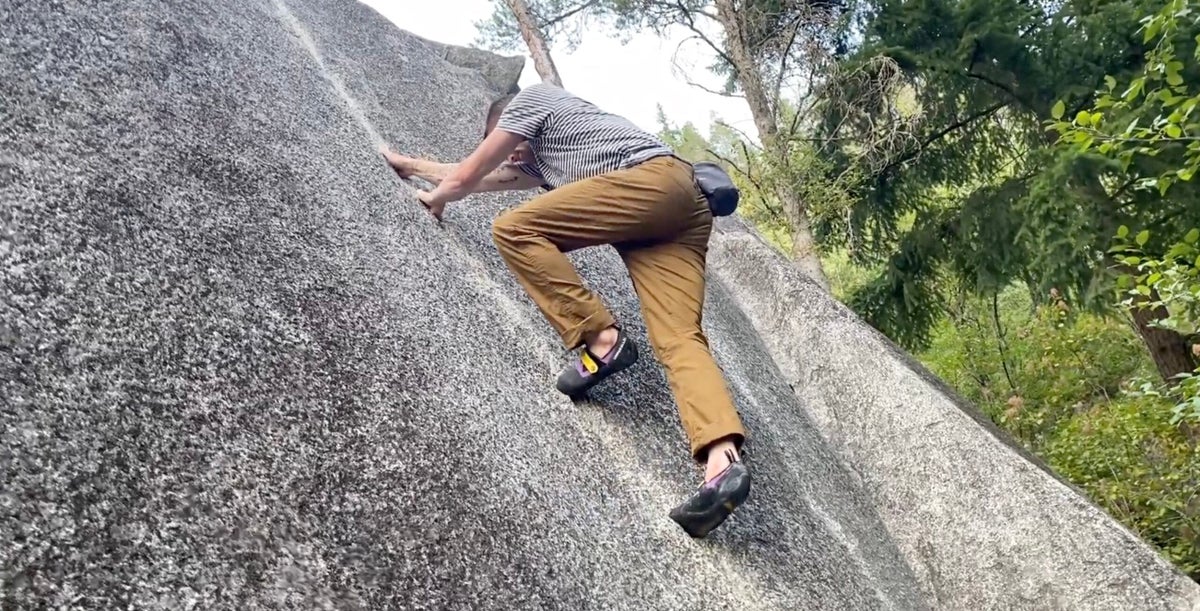
The 11 best climbing pants for sport, bouldering, trad, the gym, and more—plus our pant pick for all-around climbing.
The post We Tested 42 Different Climbing Pants. These Pairs Came Out on Top. appeared first on Climbing.
]]>
Take a look around any crag and you’ll likely see a wide variety of climbing pants. Sure, there are plenty of climbers wearing purpose-built pants with four-way stretch and techy features. But we also see people climbing in leggings, billowy linen, the occasional Lycra tight, Carhartts, and denim (the horror!). While there are many pants that you can make work for climbing, if you’re in search of the best climbing pants, you’re in the right place. We put dozens of pairs to the test, from technical bottoms and department store leggings to burly workwear.
To help guide you toward the best pair, we identified the top all-around rock pants for anyone who doesn’t want to invest in multiple pairs. We also picked top pairs for sport climbing, bouldering, the gym, and trad/multi-pitch/alpine.
Searching for climbing pants for women? While we offer recommendations for both men and women here, we also created a separate women’s-specific guide to the best pants with more detail and additional recommendations.
The post We Tested 42 Different Climbing Pants. These Pairs Came Out on Top. appeared first on Climbing.
]]>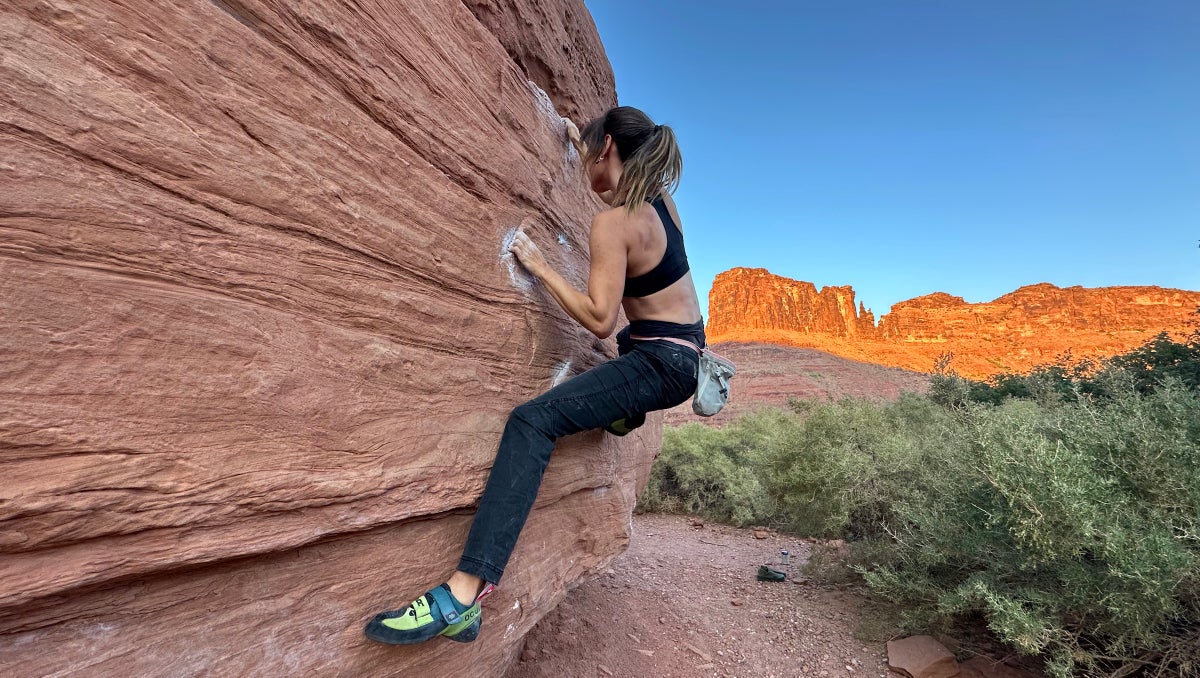
Our favorite pants and leggings for sport, bouldering, trad, the gym, and all-around climbing.
The post Of the 28 Pairs We Tested, These Women’s Climbing Pants Performed Best appeared first on Climbing.
]]>
We remember our early gumby days climbing in shorts, jeans, and other poorly chosen pants like it was yesterday. It also wasn’t long ago that climbing pants built for women left a lot to be desired. Thankfully, the pants scene has come a long way—and so have we. After climbing sport routes, trad lines, cracks, boulders, multi-pitch walls, and plastic at the gym, we know what we want in pants.
From movement-friendly design and under-harness comfort, to actually useful pockets, we evaluated over two dozen pairs of pants on a variety of climbs. We also included a mix of purpose-built climbing pants, more general outdoor pants, and leggings, for those who feel strongly that tights are the only way on rock.
Finally, if you’re looking for recommendations for both men and women, head over to this guide to the best climbing pants.
The post Of the 28 Pairs We Tested, These Women’s Climbing Pants Performed Best appeared first on Climbing.
]]>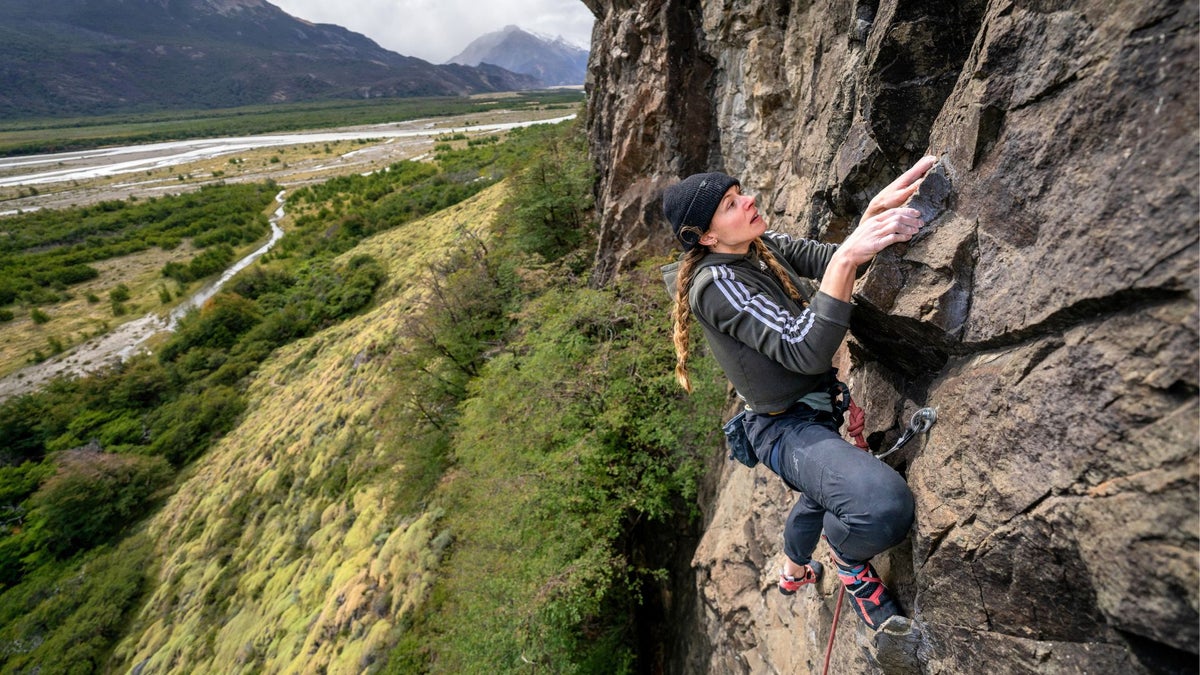
We’ve field-tested everything from beginner’s kicks to high-end weapons. Of the 48 models Sportiva makes, these are our favorites.
The post Psyched on La Sportiva? These Are the 6 Rock Shoes We Recommend. appeared first on Climbing.
]]>
La Sportiva has long been a dominant force in the global and United States rock-shoe market, their boots prized for high-octane performance, precise fit, sleek, aesthetic, meticulous Italian craftsmanship, and durability—easily withstanding multiple resoles.
La Sportiva’s climbing shoes have been integral to some of the world’s most difficult ascents, from the Solutions that Beth Rodden wore on the trad climb Meltdown (5.14c) in Yosemite in 2008, to the TC Pros that Tommy Caldwell wore on the first free ascent of the Dawn Wall (VI 5.14d) on El Capitan in 2015, to the Miura + Solution combo Adam Ondra used on the first ascent of Silence (5.15d) in Norway in 2017, to the Mandala + Solution combo Keenan Takahashi sported on the FA of The Gold Standard (V15) at the Buttermilks, California, in 2024.
Sportiva also makes more moderate climber-friendly shoes known for their comfortable footbeds, flatter lasts, and all-day or -session comfort, with the Tarantulace a longtime staple at gyms and crags.
History of La Sportiva
Founded in 1928 in the Val di Fiemme, Italy, in the heart of the Dolomites, La Sportiva is one of climbing’s most venerated mountain and rock-climbing footwear brands. The business began with the bootmaker Narcisio Delladio, who handcrafted his leather boots and wooden clogs for local farmers, and then, during WWII, mountain boots for the Italian Army. Post-war, an in-demand Delladio expanded his business to create a workshop, the Calzoleria Sportiva (“Sportive Shoemaker”), with La Sportiva’s modern HQ now based in the mountain village of Ziano di Fiemme.
In 1982, La Sportiva entered the rock-shoe market with the Mariacher, the iconic purple-and-yellow hightop. Today, the company makes mountaineering, alpine, and ice-/mixed-climbing boots, ski-touring boots, approach shoes and trail runners, apparel and technical wear, and of course rock shoes, of which, as of 2025, they have 48 different models across the men’s, women’s, and kids’ categories.
La Sportiva has long been a major innovator in rock-climbing footwear. They sold the world’s first commercial climbing slipper, the Ballerina, in 1983, pointing to a future in which climbers sought steeper rock requiring softer, slip-lasted shoes; the first “high-tension” (i.e., slingshot-rand) rock shoe, the Kendo, in 1986; and the first “No Edge” shoe, the Mantra, in 1999, forgoing the crisp, 90-degree edge where the sole meets the rand for a softer, more sensitive sole that wraps up over the toe.
Buyer’s Guide to La Sportiva Climbing Shoes
Mountain climbers, trail runners, and backcountry skiers—all of whom are also often diehard rock climbers—will know La Sportiva for their alpine boots, approach shoes, trail-running shoes, and ski boots. But here we’ll cover a handful of their most iconic rock shoes, plus what makes each one special.
Mandala
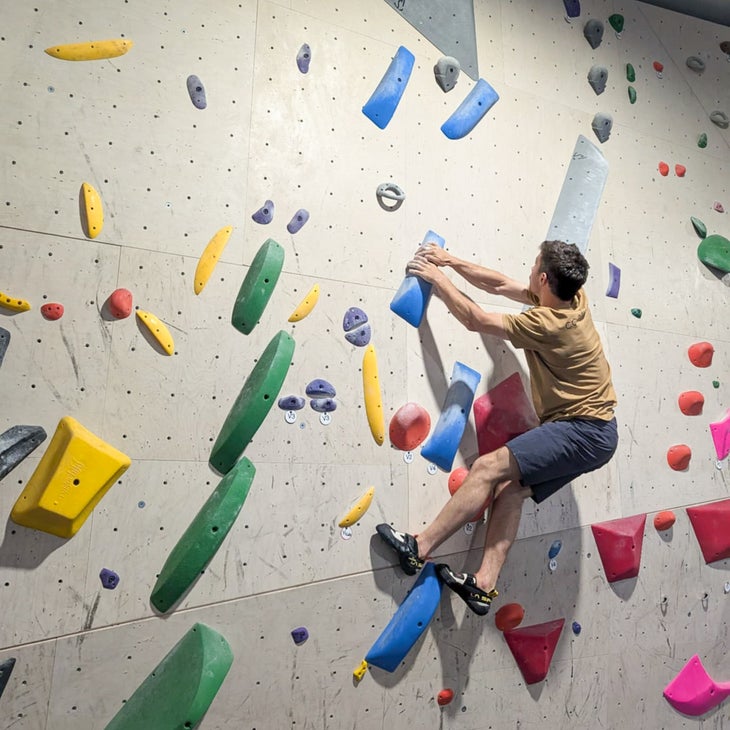
The Mandala represents the pinnacle of the No Edge line, which also includes the Futura, Genius, and Mantra—it’s the stiffest, most powerful, most versatile of the four shoes, with big-toe bite for edging and micro-edging, yet still tons of “squish” and sensitivity for steep rock and smears. The deep heelcup is a beast for technical hooks, and was key for Keenan Takahashi, hooking a patina crimp, on the FA of The Gold Standard. I used them in 2024 for the first ascent of a radically overhanging 5.14b in Colorado’s Front Range that included every manner of foot placement, from hooks, to smears, to jams, to driving down hard into jibs. Read our full review here.
Buy Mandala for $229 on lasportivausa.com
Ondra Comp

The Ondra Comp is one of La Sportiva’s softer, more rubber-coated offerings, similar to their gym/bouldering shoe the Theory in look, feel, radical downturn, and sensitivity, but with a ribbed, hyper-large rand/scumming patch for coordination climbing. Adam Ondra also designed the shoes to “smedge”—smear-edge—with marked flex in the toebox to spread the soft Vibram XS Grip 2 sole out on tiny holds. These shoes are monsters indoors and for bouldering, but also agile on sport climbs for smearing, grabbing, and lateral/vertical footwork—i.e., drop-knees—as skillfully demonstrated by Anak Verhoeven on Rainshadow (5.14d) at Malham Cove, England. Read our full review here.
Buy Ondra Comp for $229 on lasportivausa.com
Skwama

The classic, single-hook-and-loop-closure slipper the Skwama bridges the gap between La Sportiva’s intermediate offerings and its highest-end shoes, with a milder downturn and broader fit (one of La Sportiva’s widest) ideal for longer-term wear and wider/higher-volume feet. Consider them a semi-stiff sport-climbing jack-of-all-trades. They’re tailormade for somewhere like the Red River Gorge, Kentucky, where you need smearing for slabs, jamming for cracks, precision edging for vertical lines like Zen… (5.12d), a bomber heel, a pointy toe for pockets and “innie” jibs like the iron-rock nipples nested inside the sandstone pockets, and grabbing for 45-plus-degree grottoes like the Madness Cave. The Skwamas also come in a vegan version with microfiber—versus leather—uppers. Read our review of the Skwama Vegan here.
Buy Skwama Vegan (men’s) for $239 on lasportivausa.com
Buy Skwama Vegan (women’s) for $239 on lasportivausa.com
Buy Skwama (men’s) for $239 on lasportivausa.com
Buy Skwama (women’s) for $239 on lasportivausa.com
Solution
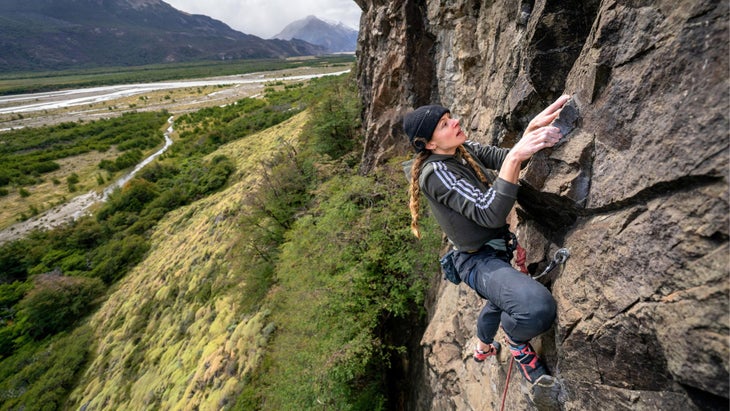
It’s crazy to think that the Solutions came out back in 2007, but these complex, multi-paneled, multi-layered shoes were futuristic then, as now. Solutions do everything extremely well, from overhanging bouldering to thin cracks to sport, and are prized for their hyper-precision on granite and limestone jibs. They’ve been used on everything from nauseatingly thin, vertical 5.15 Ondra tech, to über-steep, bouldery routes like Stefano Ghisoli’s Arco, Italy, testpiece Excalibur (5.15c), to Jakob Schubert’s repeat of the varied V17 endurance problem Alphane in Switzerland. The bulbous, rubber-coated 3D heel locks in on technical hooks but has a specific feel that takes some getting used to. Solutions are stiff, long-in-the-toe, pointy shoes, so if they don’t fit you well, try the slightly wider-footbed Solution Comp, a softer shoe that excels on overhanging terrain.
Buy Solution (men’s) for $219 on lasportivausa.com
Buy Solution (women’s) for $219 on lasportivausa.com
Buy Solution Comp (men’s) for $219 on lasportivausa.com
Buy Solution Comp (women’s) for $219 on lasportivausa.com
Tarantulace

With a price point of only $99, the Tarantulace is both one of La Sportiva’s most affordable and one of its comfiest shoes. This unlined lace-up has a flat last, beefy 5mm FriXion RS sole, and supportive 1.8mm-thick LaspoFlex midsole perfect for newer climbers wanting an edging boost, or for more experienced climbers looking for longer-term wear, as with moderate multi-pitch climbs, autobelay sessions, crag laps, etc. If dealing with the laces during on-off feels cumbersome, there is also the double-hook-and-loop-closure version, the Tarantula. Neither of the Tarantula shoes are hyper-precise, capping their upper range at around 5.12, but their comfort and neutral last will see you comfortably up through the grades.
Buy Tarantulace (women’s) for $99 on lasportivausa.com
Buy Tarantulace (men’s) for $99 on lasportivausa.com
TC Pro
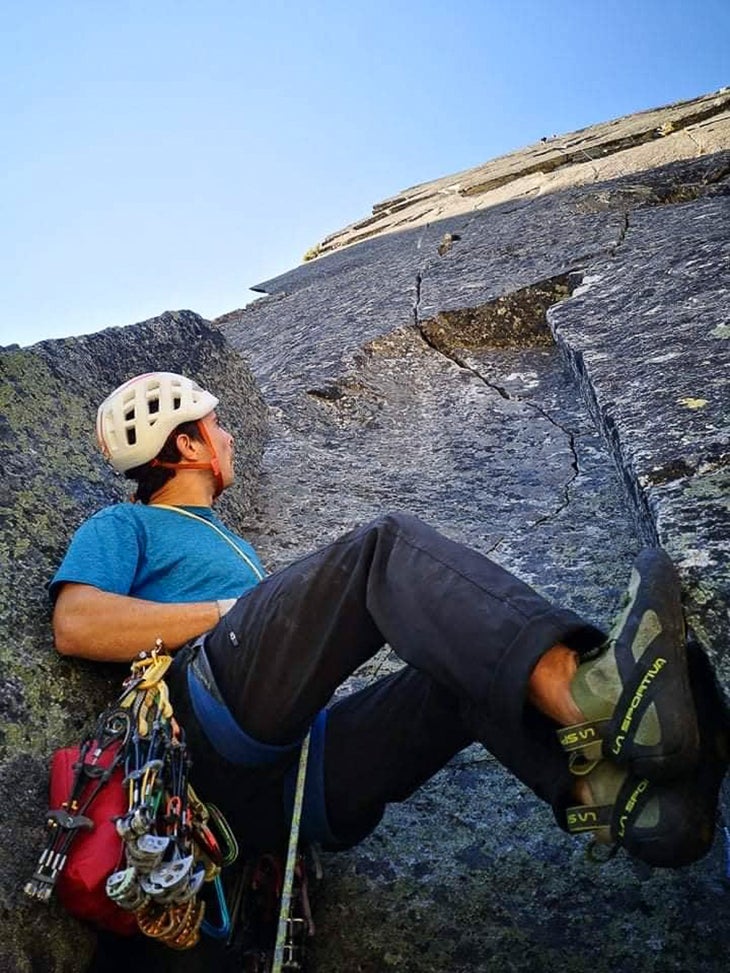
Perhaps the most niche, but one of the most powerful, shoes ever made is the TC Pro, designed by Tommy Caldwell for the endless cracks and insanely thin edging and crystal-standing of El Capitan granite. This semi-hightop is now in its second iteration, with some feedback also from Alex Honnold, who wore them on his mind-boggling ropeless ascent of Free Rider (VI 5.13a) in 2017. The TC Pros are stiff, precise, and supportive, with a chiseled, protruding toebox; they barely flex and offer minimal feedback—inspect your footholds visually. The shoes are engineered for comfort and support on long, technical traddy pitches, the new, flatter, more streamlined toe slots into thin cracks better than ever, and foam padding along the heel cuff and lacing/tongue zone offers ankle protection for wide cracks. If the TC Pro feels too stiff, check out the slightly softer Katana Lace (men’s and women’s versions), another thin-edging machine. Read our full review here.
Buy TC Pro for $239 on lasportivausa.com
The post Psyched on La Sportiva? These Are the 6 Rock Shoes We Recommend. appeared first on Climbing.
]]>
Safety, security, and storage solutions we’d recommend
The post The Gear Climbing Editors Loved in August 2025 appeared first on Climbing.
]]>
It’s been hot, and we’ve been climbing. In August, our editors sent offwidths in the heat, cooled off on creekside trad routes, trained in the gym, and got back out there post-injury. This month, we tried out new gear and continued testing equipment we love in new settings. This is the favorite gear of Climbing editors for August 2025.
Petzl Bindi Headlamp
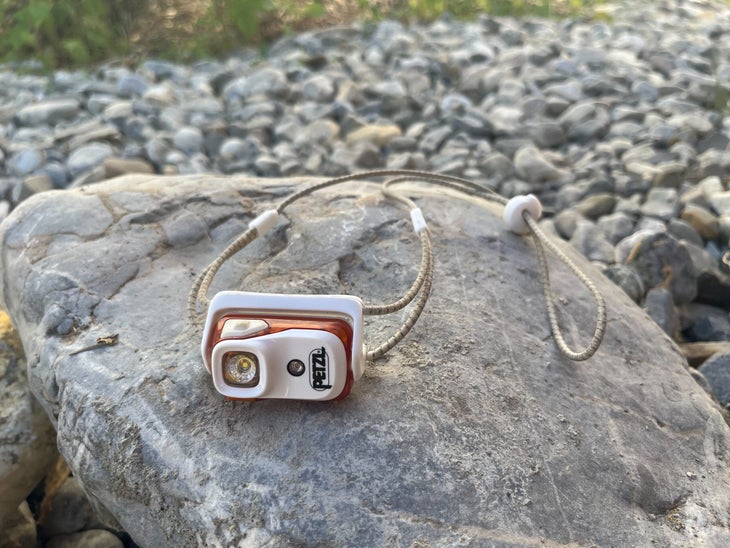
I bought Petzl’s microscopic Bindi headlamp because I was nervous—nervous about being on a big climb and dropping my headlamp at a bivy or while climbing through the night. My friend, who is a big fan of committing multi-day missions, told me I was sketchy to only climb with one. I heard his point, but deflected. Two is too heavy, and headlamps are expensive. He whipped the Bindi out of his pocket. I no longer had an excuse.
The Bindi clocks in at $45, 35 grams, and 200 lumens. The thin elastic head strap has a nearly negligible volume, and the main body is comparable to two lighters side by side. The beam rotates generously—nearly 360 degrees. And on its lowest white-light setting, this light will burn for 50 hours. The Bindi is rechargeable without any removable batteries, meaning you need to bring a power bank (or a second headlamp) if going for multiple days. As a result, it’s not the most powerful or longest-lasting headlamp I have ever used, but it’s perfect for after-work climbs and as an insurance policy on bigger outings. —Anthony Walsh, Senior Editor
Petzl Dual Connect Adjust
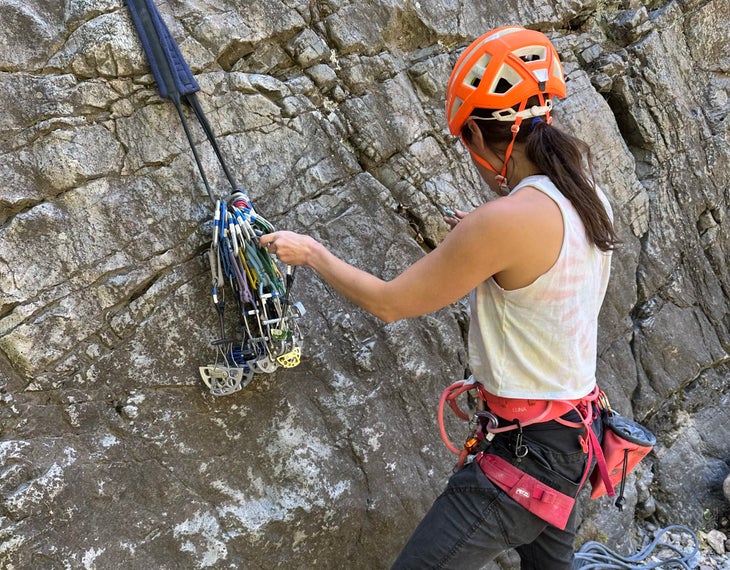
Before I loved this particular personal anchor system (PAS) from Petzl, I was a dedicated user of the Petzl Connect Adjust. The shortfall of that PAS is that if you want to use the Connect Adjust to extend a rappel but also as your PAS, you need two or a different system for extending your rappel. When I saw the Dual Connect Adjust ($79.95) at my local gear store, I bought one for my husband and began “borrowing” it (let’s be real: it’s mine now). I love that I can now use one PAS to both clean an anchor and simultaneously set up an extended rappel. Petzl also makes this PAS with dynamic rope so you can safely shock load it with a small fall (as long as the fall factor is <1). I’ve used it for cleaning single-pitch climbs, but it’s really ideal for multi-pitch rappels. —Maya Silver, Editor-in-Chief
Shop Petzl Dual Connect Adjust
Fanny Pack
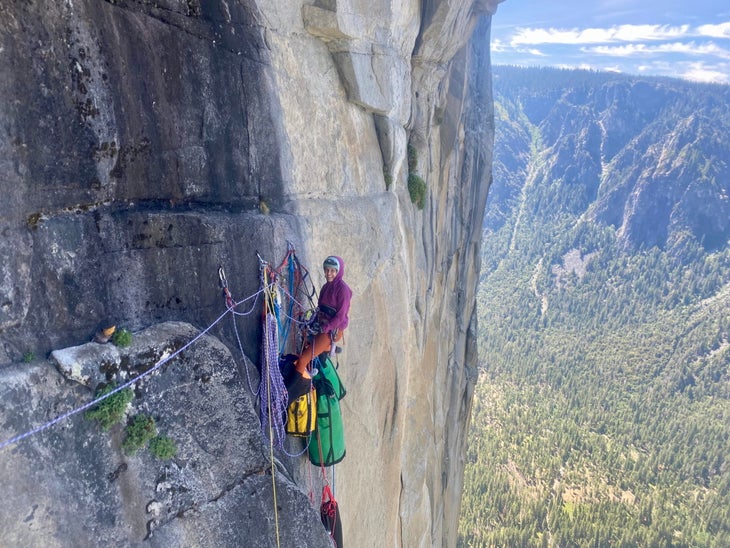
A lightweight fanny pack is my number-one climbing accessory for multi-pitch and big walls. I don’t often find it on gear checklists, but I rarely head out on a big adventure without it. Having access to my phone, chapstick, and even a snack in a pouch above my harness, at my waist, is so much more comfortable than storing those items in my pants pockets, where I can’t easily see them. When I’m belaying, for example, I can unzip the fanny pack and check the topo map on my phone’s lock screen without actually taking it out of the pack.
Recently, it’s also been useful for holding my phone and keys when I’m running in Moab, especially when I’m wearing shorts without pockets. The exact brand of fanny pack doesn’t really matter, but I prefer a low-volume, lightweight one that’s tall enough to hold my phone, like this one-liter pack from Fjallraven ($45). —Sam MacIlwaine, Associate Editor
Phone Tether for Climbing
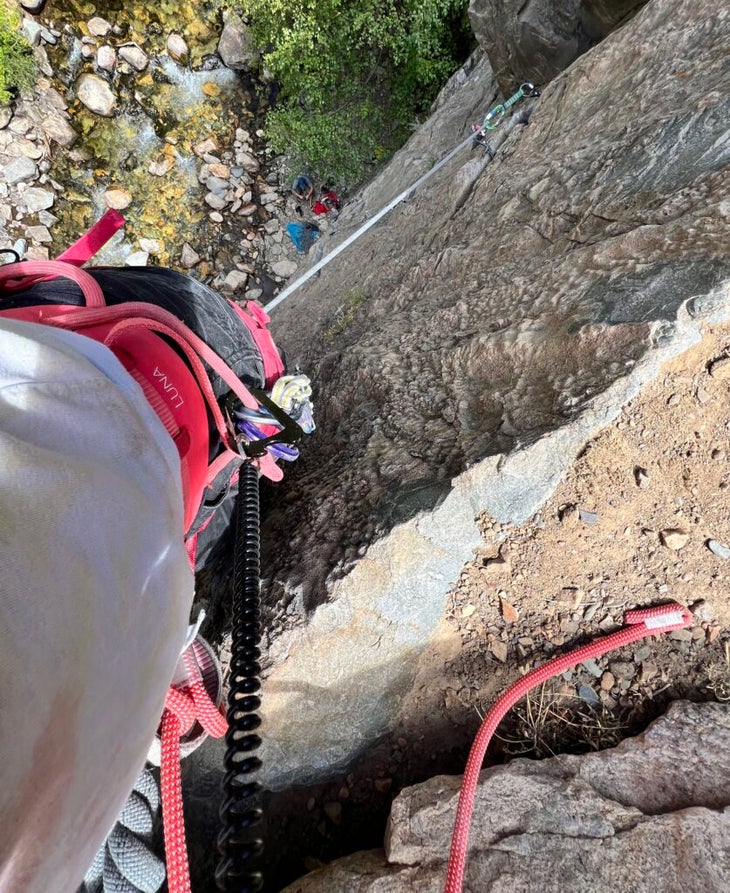
I’ve never dropped my phone from the anchor, but a fear of doing so usually precludes me from climbing with my phone. That’s sometimes a bummer if the view from the anchor is worth remembering. So when our video editor at Outside told me about these phone lanyards ($13.99), I was stoked to try out a klutz-proof way of climbing with my phone on board. This handy lanyard mounts under your case and connects to a bungee cord and carabiner. I usually clip the carabiner to my back gear loop. These come in packs of two so you can gift one to your partner, too. —Maya Silver, Editor-in-Chief
The post The Gear Climbing Editors Loved in August 2025 appeared first on Climbing.
]]>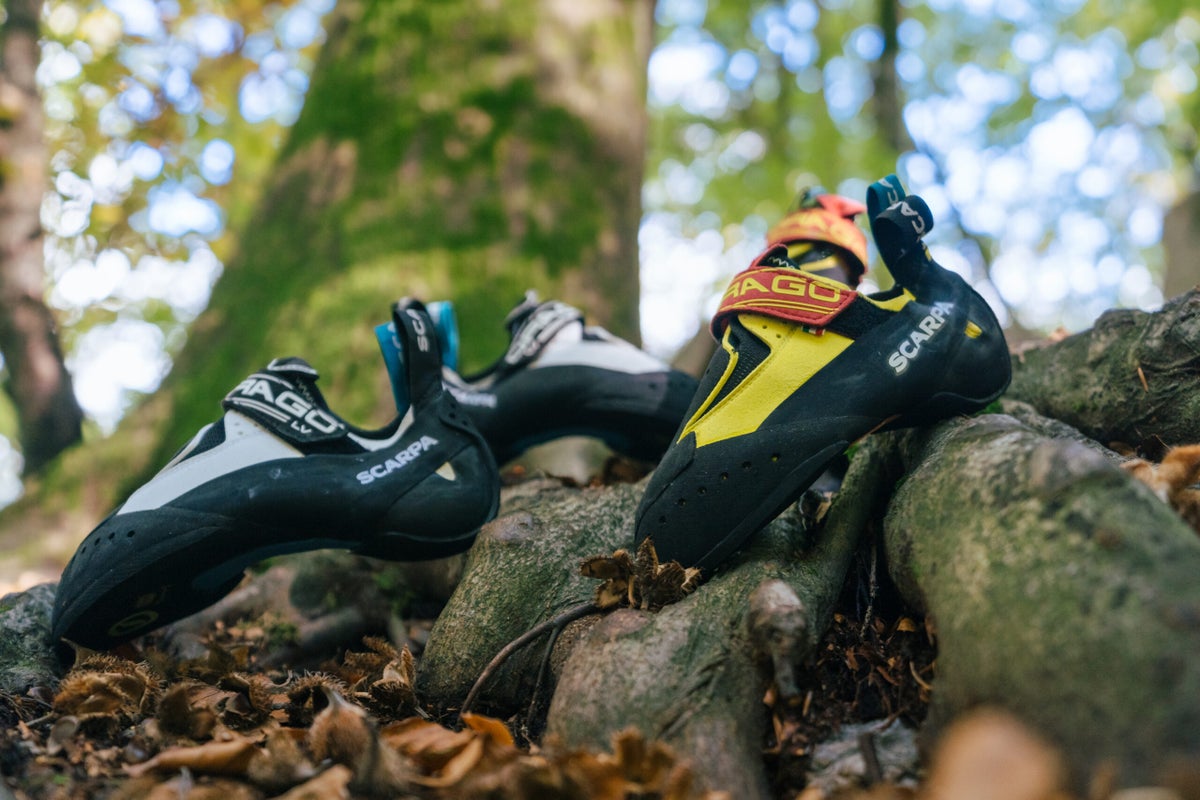
Our favorite shoes on sale during Labor Day Weekend, plus our top picks from Black Diamond's Sendtember Sale.
The post Wish You Had Fresh Climbing Shoes for Fall? These Field-Tested Pairs Are Up to 55% Off. appeared first on Climbing.
]]>
Updated August 28 – On the cusp of send temps, Rocktober, and Creeksgiving, Labor Day Sales offer climbers a chance to grab end-of-season deals before fall. This year’s roundup includes deals on some of our favorite climbing shoes from La Sportiva, Scarpa, and Evolv. We’ve also highlighted a few of our picks from Black Diamond’s Sendtember Sale.
Not sure what to look for when buying climbing shoes? Check out A Beginner’s Guide to Climbing Shoes.
Top Climbing Shoe Deals at a Glance
- 25-35% Off La Sportiva TC Pro
- 25% Off Scarpa Arpia V
- 25% Off Evolv Zenist
- 25% Off La Sportiva Mandala
- 25% Off Scarpa Instinct VS and VSR
- 25-50% Off La Sportiva Skwama Vegan
- 25% Off Scarpa Vapor S
- 30-55% Off Scarpa Quantic
- 25% Off Scarpa Drago and Drago LV
- 25% Off Scarpa Veloce
- 25% Off Black Diamond Momentum – Kids’
- 20% Off Evolv Venga – Kids’
Our 5 Favorite Black Diamond Sendtember Deals
Before we get into our shoe picks on sale below, let’s talk about the best gear you can get at 25% off during Black Diamond’s Sendtember Sale (August 28-September 1). There’s a lot on sale, from pitons and a portaledge to nuts, headlamps, and harnesses. Here are a few of our favorites from the sale.
Black Diamond Vapor Helmet $127 $170

Our ultralight helmet pick of 2025, the Vapor is among the lightest helmets on the market. With a breathable design, our testers found this helmet comfortable on big days out in the backcountry. Note that this helmet is ideal for folks with larger heads.
9.4 Dry Climbing Rope – Honnold Edition $255 $340
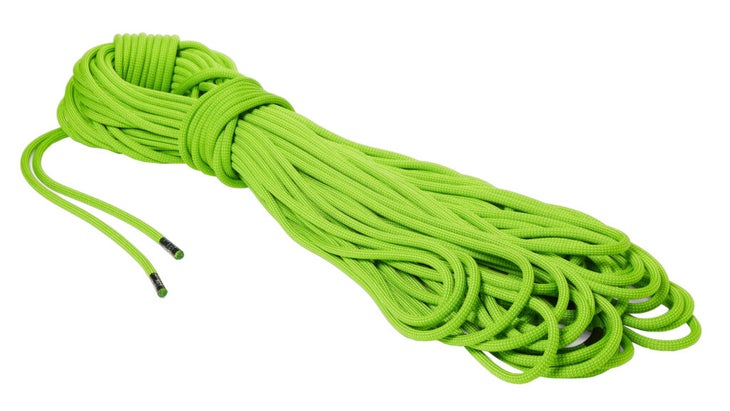
This kink-resistant rope impressed our testers with its light weight and durability. After taking big whips on this BD rope, hanging on it, and generally put it through the wringer. After a season of abuse, it showed hardly any signs of wear and tear. While this rope is a bit stiff out of the box, it was great to handle. Plus, a portion of the proceeds from each sale support the Honnold Foundation, and its mission to create more access to solar energy around the world. All in all, we chose the Black Diamond 9.4 Dry Climbing Rope as the finest rope for projecting this year.
Black Diamond Creek 50L Pack $180 $240
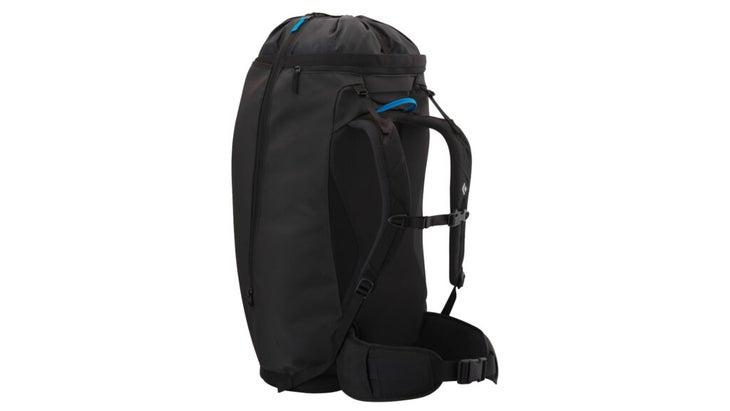
Our best crag pack of the year, BD’s flagship backpack is built to last, with thoughtfully placed pockets that make keeping it all organized a breeze. We’ve stuffed it with a rope, helmet, gear, a double trad rack, layers, and liters of liquid and taken it everywhere from Squamish to Smith Rock. The oversized top-loading opening and side zip also make accessing gear super easy. This pack is also available in 30L.
Quickdraws and Alpine Draws $58-$79 $77-$105
This is a great time to stock up on the little things for 25% less. Grab a pack or two of quickdraws or alpine draws to replace any that ought to be retired, or simply add to your gear closet. You’ll also find plenty of carabiners (including lockers), runners, chalk, and other essentials on sale.
13 Tested and Recommended Climbing Shoes on Sale
La Sportiva TC Pro ($142-$179 $219-239)
The TC Pro is a stiff, all-around rock shoe ideal for all-day wear, long routes, face climbing and cracks, and even El Cap. The shoes are unbeatable in places like Squamish, BC, North Conway, NH, and Yosemite, CA. Famously worn by Tommy Caldwell on the Dawn Wall and Alex Honnold on Freerider, the TC Pro is inarguably one of the most pedigreed granite shoes of all time. Read our full review here.
Note that an older model of the TC Pro is marked for clearance at 35% off, while a newer version is marked at 25% off.
Scarpa Arpia V ($134 $179)
The Arpia V is a lot like La Sportiva’s Miura VS. Both are excellent outdoor sport climbing shoes that shine in the 5-30 degree overhanging range. But the Arpia V is more comfortable, slightly less asymmetrical, far less prone to changing shape over the course of its life, and a little softer. This gives it versatility on varying steepness at the expense of edging quality. These shoes work well inside, too, but are a bit stiffer than some might prefer in an indoor shoe. That said, the Arpia V could be great indoor shoes for slightly heavier climbers looking for a bit more support. The “LV” in the women’s version stands for “lower volume,” which means it’s designed for narrower feet.
Shop Women’s Scarpa Arpia V LV

Evolv Zenist ($134 $179)
A soft, single-strap-closure slipper, the Zenist is known for its sensitivity and flex. It also has a large toe-hooking patch. The shoe is designed for competition climbing and excels on its coordination moves. And the Zenist Pro, U.S. climber Colin Duffy’s go-to, features more scumming rubber and a stiffer, more built-up last, which supports the foot for slab moves.
La Sportiva Mandala ($172 $229)
Our lead shoe tester Matt Samet loves this shoe, as do numerous La Sportiva athletes, including boulderer Keenan Takahashi and star competition sport climber Ai Mori. The Mandala is an excellent gym and rock shoe that feels stiffer than La Sportiva’s other No Edge shoes. This makes it proficient at steep and overhanging edging on stone. It has more weight/heft in the toebox, with just the “right amount” for big-toe activation on rock. It looks and feels overbuilt and has stretched very little, so should hold multiple resoles. Read our full review of the Mandala.
Scarpa Instinct VS and VSR
Scarpa keeps making different versions of its ever-popular Instinct—first released more than 15 years ago—and it’s getting hard to keep track of them. But these versions are favorites of our staff, our reviewers, and probably various shoe nerds in your gym.

Instinct VS ($164 $219)
One of the most beloved shoes of the past decade, the Instinct VS is a master of all angles. When it was first released, one of our testers (who has more than 100 shoes in his personal collection) had high praise: “I’m just gonna say it: This is one of the best shoes I’ve ever worn,” he wrote. “They’re versatile, comfortable, and outperform almost any other shoe on every kind of terrain.”
Shop Women’s Scarpa Instinct VS
Instinct VSR ($164 $219)
Built almost exactly the same last as the outstanding Instinct VS, shoe designers put a softer rubber on the Instinct VSR, making it generally preferable for gym climbers, boulderers, and route climbers who keep to the steeps. The Instinct VSR won our 2017 Editor’s Choice Award and has remained a go-to for several of Climbing’s writers and editors. But if you’re looking for elite edging performance, consider the Instinct VS instead. The “LV” in the women’s version stands for “lower volume,” which means it’s designed for narrower feet.
Shop Men’s Scarpa Instinct VSR
Shop Women’s Scarpa Instinct VSR LV
La Sportiva Skwama Vegan ($100-$164 $199-$219)
Though the Skwama is softer than La Sportiva’s Solution line, and therefore doesn’t edge quite as masterfully, it’s still a highly versatile shoe. The Skwama performs well on everything from vertical basalt sport climbs and technical limestone cave boulders to marathon gym training sessions. In sum: A high-performance slipper-velcro hybrid that’s excellent for just about everything—and animal-friendly to boot. It’s included in the Our Favorite Sport Climbing Shoes roundup. Note that an older model of the Skwama Vegan is marked for clearance at 35% off, while a newer version is marked at 25% off.
Shop Men’s Newer La Sportiva Skwama Vegan
Shop Men’s Older La Sportiva Skwama Vegan
Shop Women’s Newer La Sportiva Skwama Vegan
Shop Women’s Older La Sportiva Skwama Vegan
Scarpa Vapor S ($149 $199)
Scarpa’s Vapor S is a comfortable, performance-oriented slipper that excels equally well on systems boards, polished limestone, slabby volumes, and edging terrain. Unlike most slippers—and most shoes on this list—it’s a relatively flat shoe (better for the flat-footed among you) and quite wide. But it’s also incredibly versatile—great for paddling up caves in the Red River Gorge and torquing up cracks in Squamish. They appear on our roundup Our Favorite Sport Climbing Shoes, but Aidan Roberts also wore one on while working on Spots of Time, the UKs first V17 boulder. Read our full review here.
Scarpa Quantic ($83-$129 $185)
The Quantic is an all-arounder shoe that performs just fine on everything, but truly well on nothing. The key selling point of this shoe? It’s comfortable and affordable. It does far better in the gym than on rock, but our testers have climbed as hard as outdoor V9 and 5.13 with the Quantics on board. Almost all of our testers raved about comfort, which makes it a good training/gym session shoe. As their designer, Heinz Mariacher, says, “My intention was to offer a multi-purpose performance shoe, a mix of lightness, sensitivity, and good precision.” The Scarpa Quantic represents a step up into more advanced footwear for newer or intermediate climbers. Note that the women’s version is more deeply discounted (55% off) than the men’s version (30% off).
Scarpa Drago & Drago LV ($172 $229)
The Drago is arguably the most popular high-performance shoe on the international competition circuit. It’s also climbed many of the world’s hardest sport routes and boulders outside. One of our testers wrote: “The Drago defies standard climbing-shoe dichotomies. It’s a performance model that’s comfortable. An aggressive downturn makes it supple enough to smear on the smallest of smidges. It’s super soft, yet can toe on tiny edges as well as, if not better than, stiff edging-specific shoes, due to the midsole. It was designed as a specialized sport, bouldering and competition shoe, yet makes an excellent all-arounder; just don’t try to crack climb in them.”
What’s the difference between the Drago and the Drago LV? Width. Climbers with narrower feet should go for the LV version.
Scarpa Veloce ($134 $179)
Both the OG Veloce and the Veloce L (the “L” stands for “lace) are soft shoes, designed for the combination of comfort and smear performance desired (or so says Scarpa) by beginner and intermediate climbers who spend most or all of their time at the gym. The Veloce L is solid on anything steep and/or smeary—from board and volume climbs in the gym to limestone caves, vertical cobble climbs, and steep basalt sport routes. If you’re looking for edging performance, though, run like the wind away from this shoe. Read our review of the Veloce L, entitled Scarpa’s Latest Shoe Made me Feel Like a Con Artist.
Kids’ Climbing Shoes on Sale
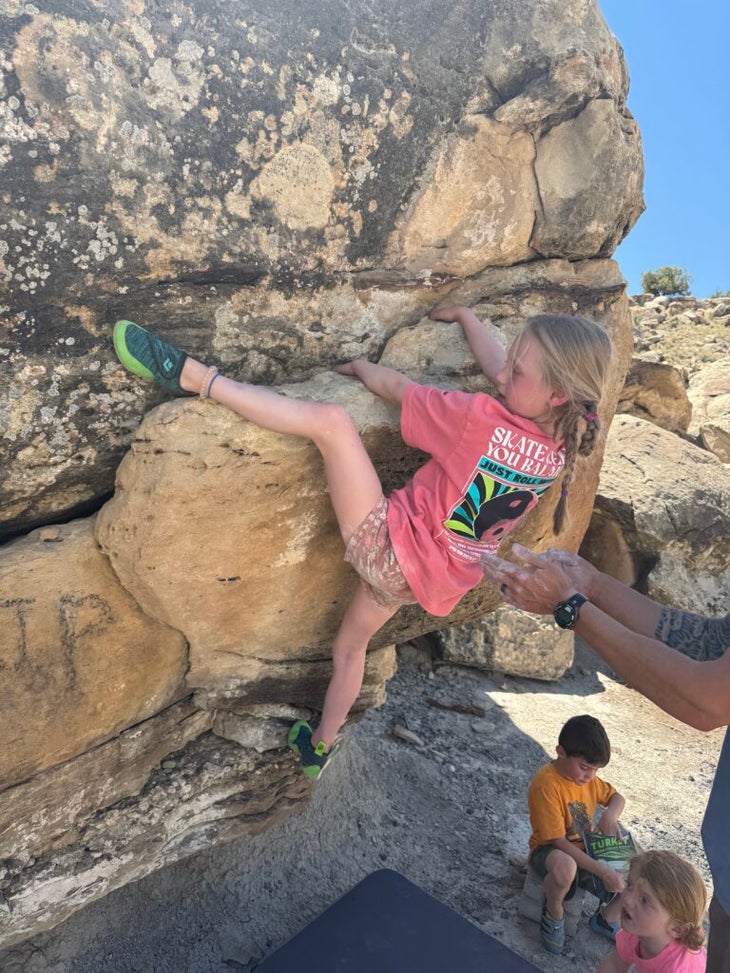
While we haven’t officially reviewed kids’ climbing shoes, there are two pairs on sale—one of which an editor’s daughter has been climbing in for two or three years. Evolv’s Venga Climbing Shoe for kids is also on sale.
Shop Kids’ Black Diamond Momentum
Tips for Climbers Shopping Labor Day Shoe Deals
Want to avoid returning that pair of shoes you scored at a discount during a Labor Day Sale? Here are some tips:
- Buy from a brand that you already know your size in vs. trying a new brand.
- Shop Labor Day Sales early before your shoe size sells out! We see this happen all the time. Usually, there is limited inventory left of past season shoe models. Retailers are trying to burn through this excess before releasing next season’s models. So supply may be quite limited.
- If you can, try on the shoe at a store or gym beforehand to make sure it’s the best size for you.
- When you see “LV” after a shoe name, it indicates “lower volume.” These versions are designed for narrower feet. If you’re male with narrower feet, you can convert your size and opt for an LV pair, even if it’s also marked as “women’s.”
- Before you panic and initiate a return, remember that climbing shoes take time to break in. That said, you don’t want to break them in too much, to the point that you wouldn’t be able to return them.
The post Wish You Had Fresh Climbing Shoes for Fall? These Field-Tested Pairs Are Up to 55% Off. appeared first on Climbing.
]]>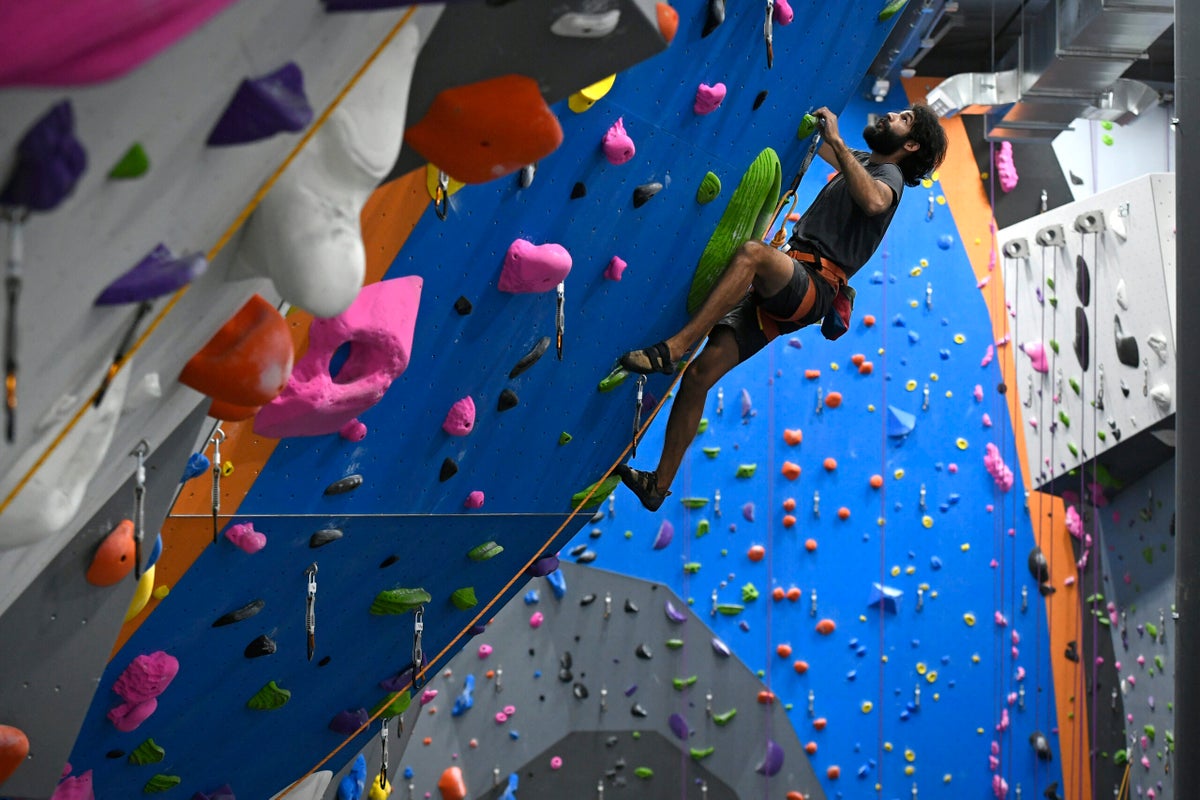
Essentials for gym climbers, tested and recommended
The post The Ultimate Gym Climber Starter Pack appeared first on Climbing.
]]>
So you’re committing to gym climbing and are officially over the stinky rental gear? You’re in the right place. We’ve identified some of our top, field-tested products for indoor climbing and training. If you’re on a tight budget, you can always buy one thing at a time while continuing to rent the rest of the gear you need. Dedicated boulderers: You can ignore the recs for harness, rope, and belay device.
In general, boulderers should expect to spend between $230 and $370 on their gym climbing gear list, while roped climbers can expect to drop between $600 and $750 (presuming you also plan to lead and therefore need a rope). If you’re getting into climbing with a friend, you could also share and split the cost of gear like a rope and belay device.
Other gear not included on this list that you might want to spring for down the line? Belay glasses for long sessions that leave your neck sore, dedicated climbing pants, a rope bag/tarp (or a budget laundry basket) to cart your rope around, and, if you’re so inclined, a mini tripod to film yourself on your project.
Avid gym climber Avianna Frady discusses what to look for when you start investing in your gym climbing
The post The Ultimate Gym Climber Starter Pack appeared first on Climbing.
]]>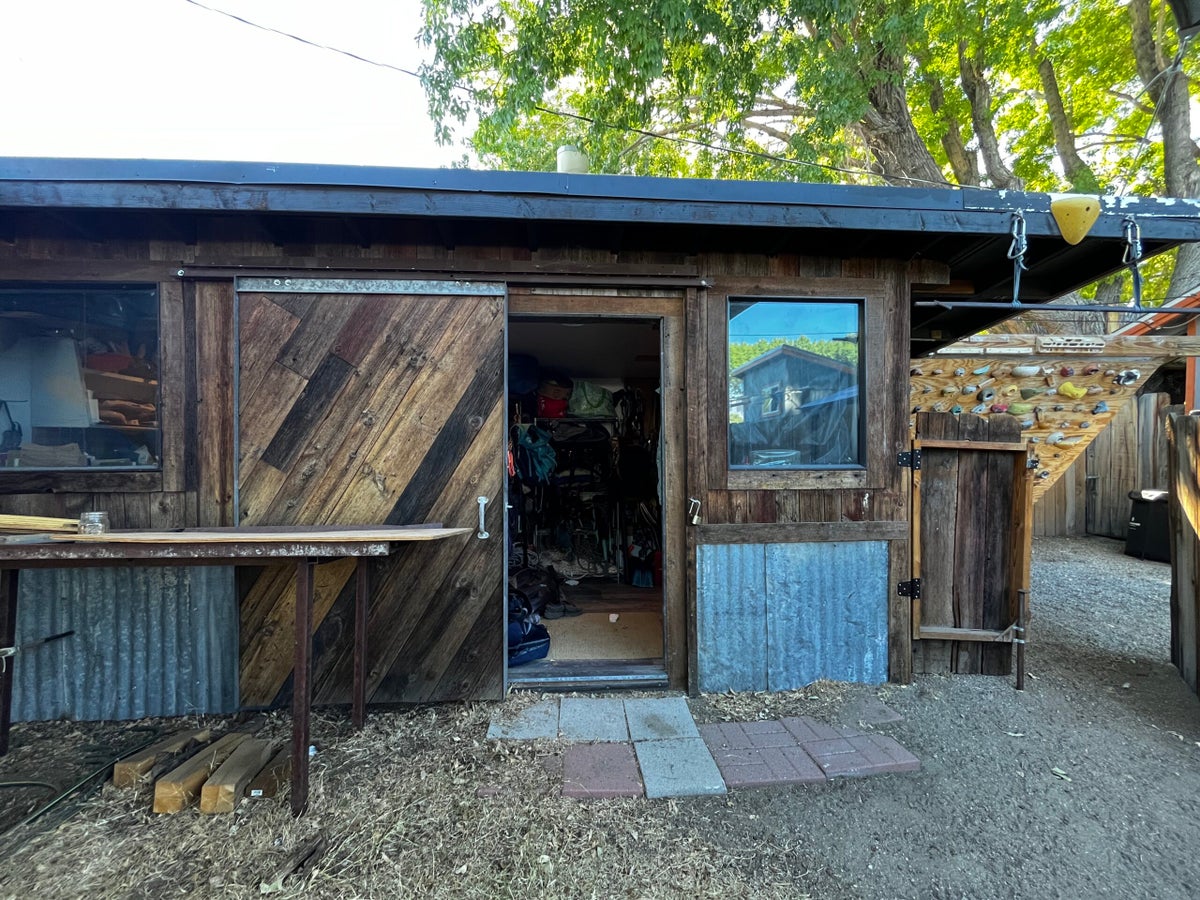
Katie Lambert shares her gear storage tips and top picks
The post A Pro Climber’s Custom Gear Shed—and Her Favorite Things Inside It appeared first on Climbing.
]]>
With three decades of trad, sport, bouldering, and big wall experience, Katie Lambert knows volumes about the best gear—and how to organize it. Born in Louisiana but long based in Bishop, California, Lambert designed and built out a gear shed with her husband Ben Ditto, a climber and photographer. When she’s not climbing, Lambert can be found working at the nonprofit Sacred Rok, which helps provide underserved youth access to climbing and the outdoors in the Yosemite area.
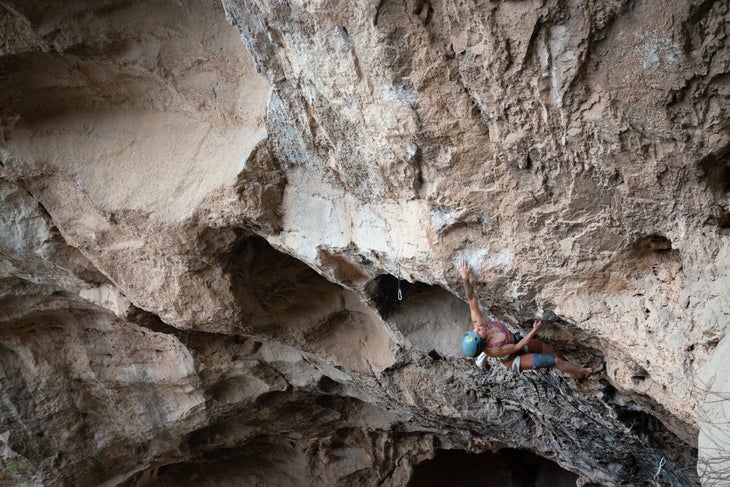
Before we get into her gear storage layout—and what she fills it with—we caught up with Lambert to see what she’s been up to this season. Recently, she got the second ascent of High Country Lover (5.14b/c), a sport route in Pine Creek Canyon. “Situated at 8,200 feet and south facing, conditions were a major obstacle,” Lambert says. “But so was my power and power endurance.” But she trained hard, locked in, and redpointed the route in spring.
Since then, Lambert has been climbing for fun on alpine peaks and taking day trips to The Incredible Hulk. She’s also making steady progress toward her goal of sending 300 5.13s by 2030—she’s currently holding strong at 202 5.13s.
A dream custom climber gear shed
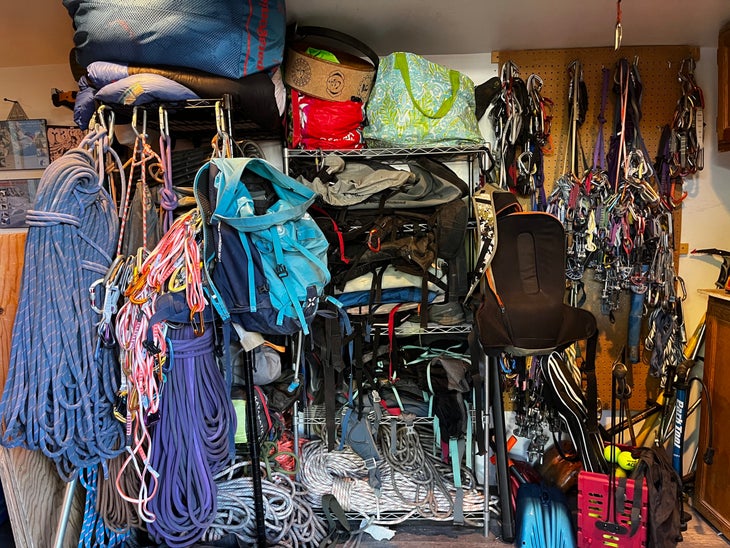
To store all the gear she needs for her 300 x 5.13 project, get into the alpine, and climb across disciplines, Lambert built a custom gear shed with Ditto on their property in Bishop. They equipped it with built-in shelving and peg boards to hang and organize their gear.
Here are a few tips from their shed setup:
- Hang all draws, cams, and slings on a peg board.
- Stack all packs, ropes, and sleeping bags on shelves for ease of access.
- If you’re building out a closet or shed of your own, gather all your gear and measure the area it takes up to determine how big it needs to be. Inevitably, you’ll probably need more room down the line as you acquire more gear. So if you can, make your shed bigger than it needs to be based on your current gear collection size.
What’s inside Lambert’s shed

These are some of Lambert’s favorite pieces of climbing gear, from her favorite helmet to the essentials-only bag she takes on big walls.
Mammut Assist Belay Resistor
I’m a very petite climber and it’s the rare occasion that I’m climbing with someone of lighter or equal weight. I’ve no problem giving a soft catch but I can often get pulled up too high or even pulled in too close to the first piece of protection. The Assist Belay Resistor is a lightweight piece I don’t mind carrying with me to the crag if I know I’ll be giving some catches where my climber is likely taking big falls.
Editor’s note: Mammut will release its Assist Belay Resister in spring 2026. Other options include the Edelrid Ohm (or wait a few weeks for the soon-to-be-released and improved Edelrid Ohmega), or the Raed Zaed.
Alien Revolution Offset Cams
These may be a little obscure to come by these days. But if you’re in the market for cams that work exceptionally well in limestone pods, fissures, and ripples, then these beauties are worth seeking out. They also never blow in flared granite pin-scars, and can fit the straight-in sandstone cracks. My favorites are the blue/black, blue/green, green/yellow, and yellow/red.
Shop Alien Revolution Offset Cams
Asana Rock Star Pad
The thing you need to cover gaps between your bordering pads—or even to use as a nice little spot off the ground for the sit starts. You can also toss it over a rock or root that may stick out the side of the padded zone, but is still potentially in the “landing zone.”
Mammut Rime Light Flex Vest
Living in the Eastern Sierra, I’m often climbing in the winter on south-facing cliffs in 30ish degree weather. In the summer months, I enjoy a bit of “Calpinism” that requires a little something extra, but not quite a full jacket. This vest is just the thing and is also awesome for cold road bike rides.
Mammut Workhorse HMS Screwgate Carabiner
This is Mammut’s largest locking carabiner, but it’s also fairly light. It’s a must-have for wall climbing. It allows for plenty of room and versatility, from loading with gear at wall bivies, to fixing portaledges, ropes, and haul bags.
Shop Mammut Workhorse HMS Screwgate Carabiner
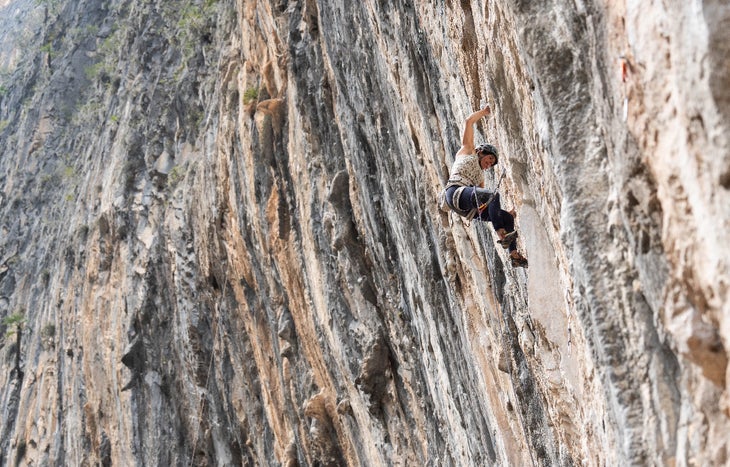
Organic Climbing Ditty Bag
Perfect for storing everything from nail and skin maintenance kits, to cell phones, headlamps, and extra wall or trail snacks.
Shop Organic Climbing Ditty Bag
Patagonia Duckbill Cap
Super light, easy to pack away, and great for running and biking. Its low-profile design allows for comfort and functionality under a helmet for multi-pitch climbing in the sun. It also fits well under a sun hoodie.
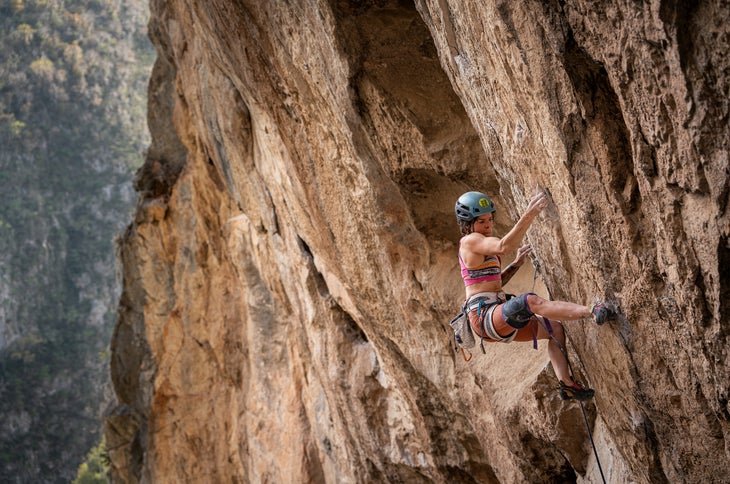
Mammut Wall Rider Helmet
It’s light, comfortable, and gives all the protection you want from a climbing helmet.
Katie Lambert is a sponsored Mammut North America athlete and she is on the Pro Team for Physivantage.
The post A Pro Climber’s Custom Gear Shed—and Her Favorite Things Inside It appeared first on Climbing.
]]>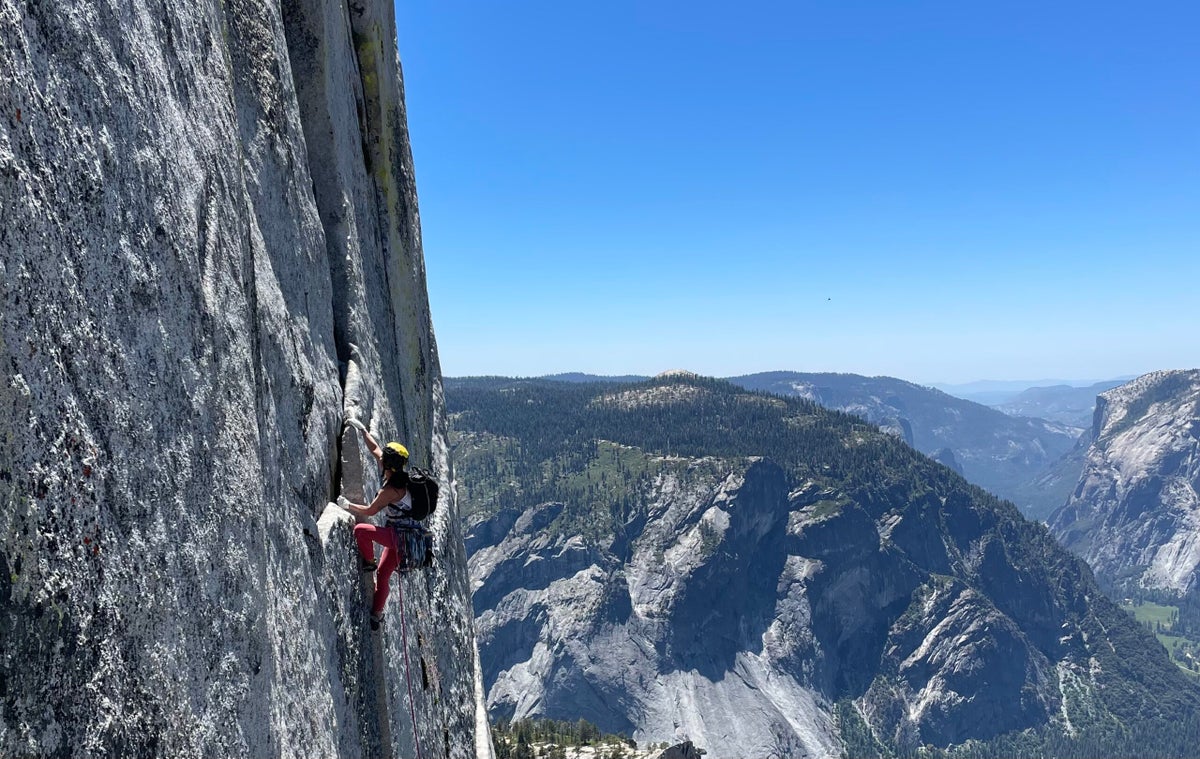
The "Brazilian Climber Girl" shares the gear she won’t climb without
The post 5 Gear Picks the “Brazilian Climber Girl” Swears By While Training for Patagonia’s Seven Summits appeared first on Climbing.
]]>
Offwidths, big walls, ice. Gisely “Brazilian Climber Girl” Ferraz has a variety of passions as a pro climber. But her big goal right now? Ticking off the Seven Summits of Cerro Chaltén in Patagonia. With two peaks left—Aguja Poincenot and Aguja Mermoz—she is focused on training right now for her objective. “I’m currently spending my summer in the High Sierra and Yosemite,” Ferraz says. “This place makes me so happy. I’ve been focusing on alpine climbing to train for Patagonia.”
Recently, Ferraz climbed Half Dome in 10 hours and 10 minutes, and ticked the Tuolumne Triple Crown. She’s also exploring lines on The Hulk and chasing some Peter Croft routes. Here are five of her all-around gear picks.
La Sportiva TC Pro Shoe
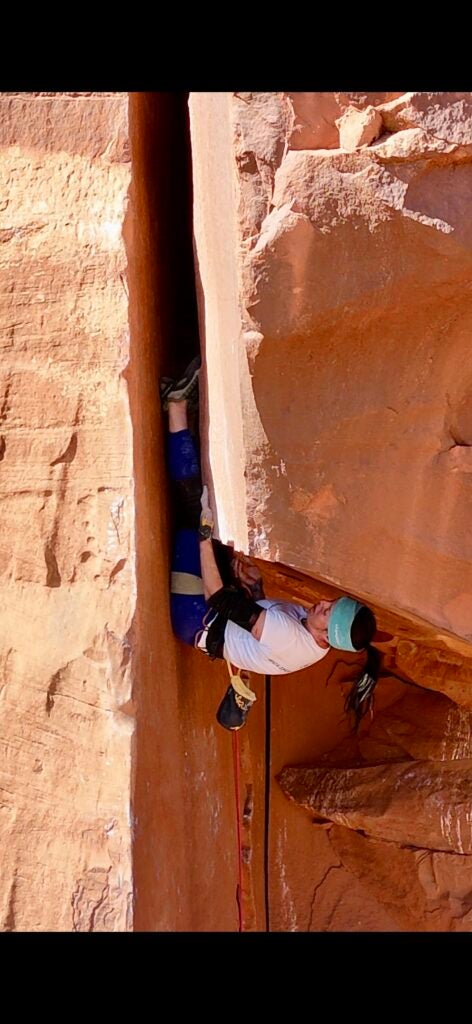
The best! My favorite piece of gear is hands-down the TC Pro from La Sportiva. These shoes are awesome. I can climb just about anything in them. From offwidth invert, techy trad routes to big walls and granite to sandstone cracks, they deliver every time. They’re incredibly versatile. I never leave for a mission without them. When they’re brand new, they can feel a little stiff or unusual, but give them some time to break in and they’ll become your favorite crack climbing shoes.
La Sportiva TX4 Approach Shoes
The best approach shoes I’ve had so far. The La Sportiva TX4s are my go-to—they’re wide, incredibly comfortable, and offer excellent grip, even solid enough for moderate climbing. They perform great on rope ascents, with enough protection to keep aid ladders from digging into my feet. For wide-footed climbers, the fit is spot-on. I’m also loving the new Stone Blue/Cherry Tomato color—looks fantastic.
Shop La Sportiva TX4 Approach Shoe
Grivel Dark Machine Ice Axe
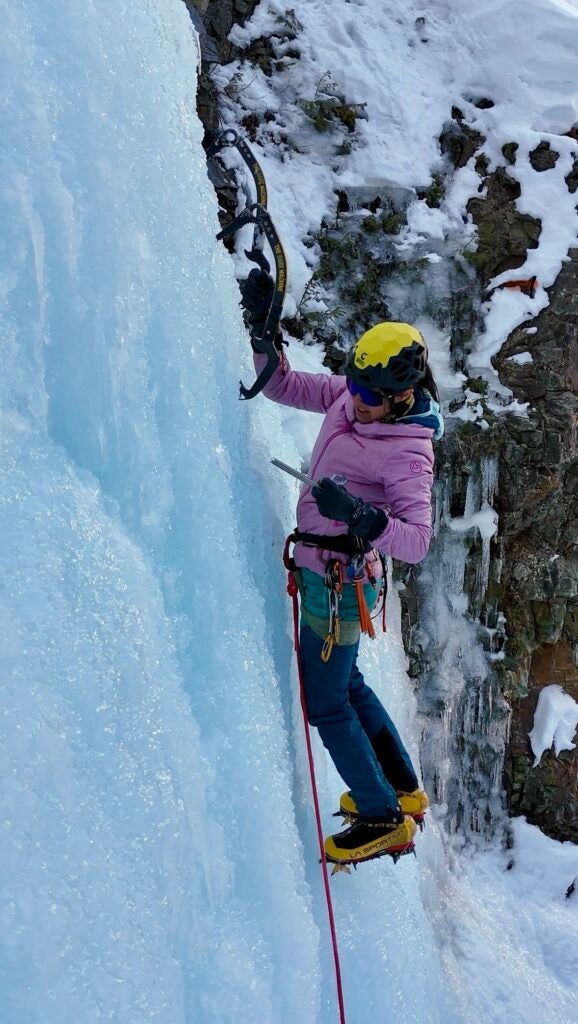
The Grivel Dark Machine is my favorite ice tool. Even the name is cool. It’s light, strong, and delivers precise performance on steep ice and mixed terrain. The swing feels smooth, the grip is solid, and it’s a tool I rely on when the climbing gets serious.
Shop Grivel Dark Machine Ice Axe
Julbo Fury REACTIV Sunglasses
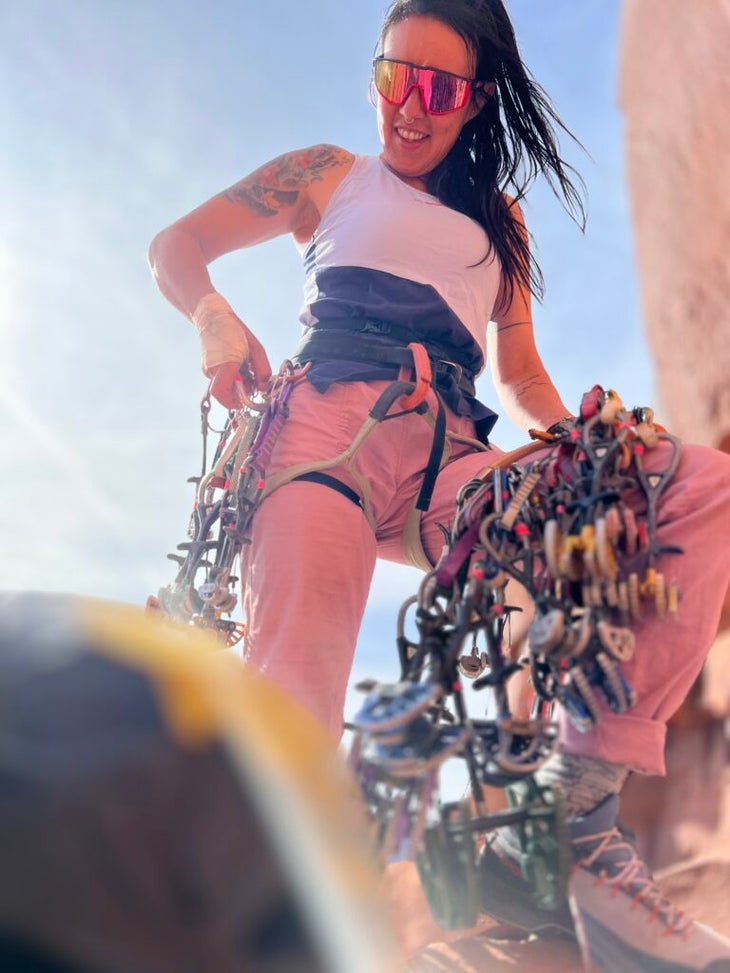
Sunny days in the alpine can be brutal on your eyes. I love these shades because of the REACTIV lenses—they adapt fast to changing light conditions. Whether I’m in full sun, shadow, or moving fast through mixed terrain, I can keep rolling all day without swapping lenses. Plus, the frame is super lightweight, making them perfect for long missions. I wear them all day and they don’t bother my ears.
Relevant read: How Gisely Ferraz Rigs Her Van as a Gear Closet
Paka Sun Hoodie

During alpine summer days, protecting myself from the sun is a must. The fabric of this hoodie is soft and made from natural fibers, so it doesn’t need constant washing, it doesn’t hold odors, and I can wear it over and over again. It’s perfect for climbers that can’t do laundry often, for living in the van, and for travelling!
Ferraz is sponsored by La Sportiva, Grivel, Paka, and Julbo Eyewear.
The post 5 Gear Picks the “Brazilian Climber Girl” Swears By While Training for Patagonia’s Seven Summits appeared first on Climbing.
]]>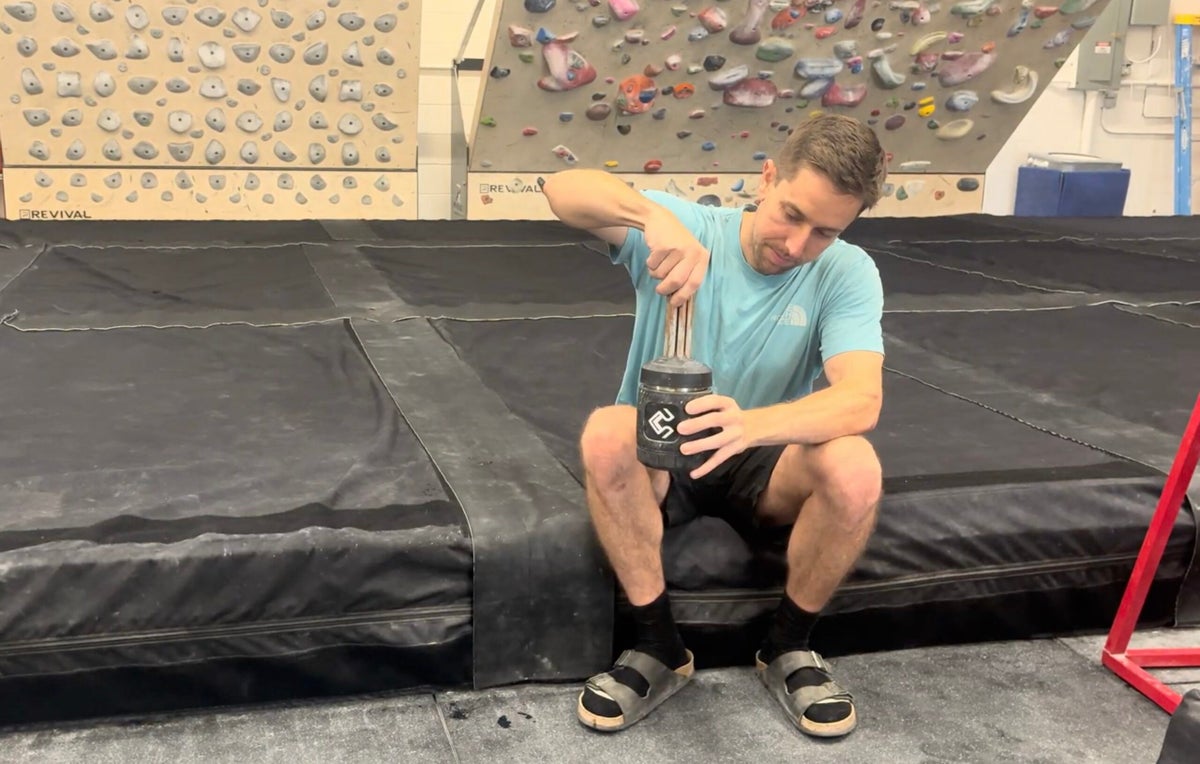
The makers of the "Narwhal" claim it can be used to reduce sweat and increase friction. Matt Samet puts that to the test.
The post Does This Weird Hand-Cooling Device Actually Make You Climb Harder? appeared first on Climbing.
]]>
One hot summer day in the early 1990s, my friend John and I watched, dumbfounded, as a pro climber misted himself off with a spray bottle at the Hell Cave in American Fork Canyon, Utah.
“What a loser,” I said, sotto voce. “As if that’s going to make a lick of difference.”
The pro climber explained to his subman, now enlisted to mist off his exposed back, that the water brought his core temperature down, in turn cooling off his fingers and toes so he could send harder. “Ooh, my core’s on fire—mist me off, bro!” John and I snickered from behind the trees like the snarky little creeps that we were.
Who is this guy who cares so damn much about climbing? I wondered. But then also: I wonder if it works.
Hot climbing, of course, is a misery: your hands sweat, nuking friction; sweat pours into your eyes, obscuring the holds; your shoe rubber feels squishier than a grilled-cheese sandwich on a hot dashboard; you get dehydrated, crampy, and grumpy; and there’s even a risk of heat-related illness like heat exhaustion or heat stroke, though we climbers generally do a good job of avoiding the scorching sun.
Which is to say, why not try to cool yourself off when the “sendex”—heat + humidity—is high, be it with fans, spray bottles, cold packs, dry ice in the chalkbag (yes, people do this!), or the clever, little gizmos called Narwhals you may have seen in bouldering videos or at your local gym?
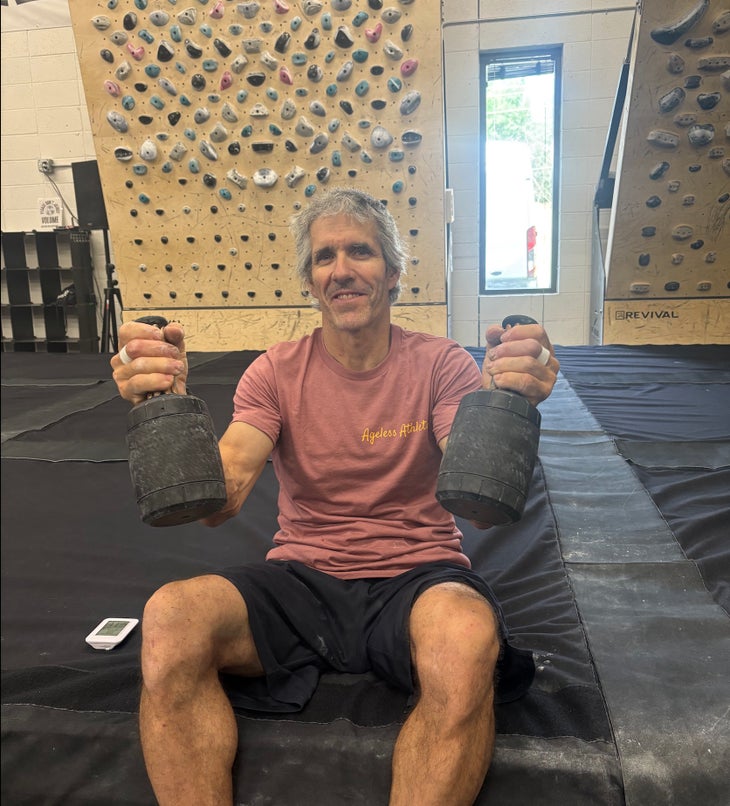
Made by the small company Apex Cool Labs in Boulder, Colorado, Narwhals showed up at my local training and boarding gym, The Campus, a month or so ago, but it was spring then so I paid them little heed. However, even climbing gyms have varying conditions, so I was happy to give the Narwhals a spin on a handful of hot, muggy late-June days (70-degree air temperature, 63-71 percent humidity), the kind where sweat flows the moment you do more than three moves in a row and your dermis flays off like onion skin.
The Narwhals are easy to use—you simply unscrew the lid, add water, grab the “Cool-Not-Cold” packs out of the freezer, drop them into the water, screw the lid shut, and let the Narwhals sit 10 minutes so the copper coils can chill. Then you hold the coils as you rest—perfect for between routes or board rips, and also a good way to prevent idle hands from doomscrolling.
Per Apex Cool Labs’ site, there is some science behind palm cooling. Our palms and soles contain glabrous (smooth) skin with arterio-venous anastomoses (AVAs): the prodigious blood flow in these “direct connections between small arteries and small veins” means that you get a 10X cooling effect over other skin regions, claims the website. So, if you’re overheating, one of the quickest ways to cool off is via your palms or feet.
Watch Matt Samet test the Narwhal:
The Narwhals were developed for endurance athletes (cycling, running, etc.) who routinely experience high body temperatures but also people who work in jobs with exposure to prolonged heat (firefighters, etc.). So it just happens to work to us climbers’ advantage—despite the fact that ours isn’t really an endurance sport—that you also grasp the Narwhals using our main point of contact with the rock. In other words, we get the double benefit of cooling our bodies and our palmar skin.
So, did the Narwhals work, or was it mumbo-jumbo? As I said, these were far-from-prime days when I used them, providing ideal conditions for testing. I began by holding them between burns on my warmup and mid-session climbs, doing one problem a minute in the V4-V7 range for 10 minutes on the Tension Board 2, with my heart rate up, breathing accelerated, and sweat lightly flowing. The Narwhals are deliberately cool—not cold—so you can clasp them for minutes on end without frozen skin: these aren’t painful cold packs. The cooling effect was subtle and pleasant, and I did notice feeling overall less hot and sweaty, which in turn made me less frantic on the board.
But best of all, with my chronically slick, hard, dry skin, the coils’ near imperceptible moisture made my palms and fingers “sticky,” and I was able to, with a chalk base on, often go straight to TB2 after holding them, skipping my usual ritual of spraying my hands with a spray bottle (yes, I know…), lightly drying them, and then chalking.
The real test would be sloper problems, where cool hands are king. First, I selected the TB2 Classic The Silver Mountain (V9 at 35°), which has a stab off a micro-crimp nugget to a full-hand sloper which must be controlled, bumped off to a soap-bar slimper, and then recycled for the finishing lunge. The Silver Mountain had eluded me, so I gave it a whirl despite the 70 percent humidity.
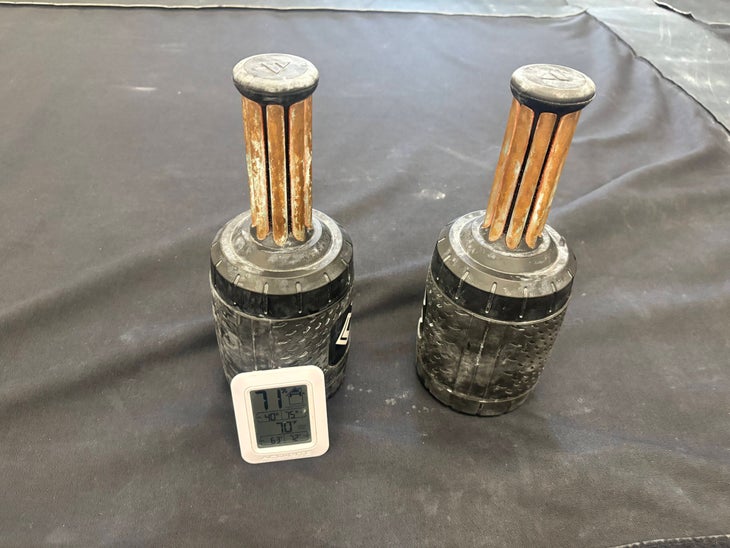
Lo and behold, I sent The Silver Mountain on my third go after nearly doing it the first two, when I came up a centimeter short on the last move. After I grasped the Narwhals for a few minutes before each burn, my skin felt pliant, gummy, cool, and grippy, and the sloper felt like a jug, whereas before I’d often dry-fire. Maybe I was just having a good day. Or maybe it was placebo—a few of us boarding joked that the real magic was the mere act of doing something between burns; I could just as easily have come down and hugged a teddy bear. Regardless, I saw positive results, and, as this first session wore on, the cooling action had a welcome painkilling and skin-preserving effect, letting me climb a good four hours, versus my usual two or three.
On another, even worse day on which I was a sweaty mess—having just come back from cragging in the Flatirons—I used the Narwhals to good effect again on my warmups and then pulled up another unvanquished baddie from my project list, Spinnin, a V9 at 40°. This problem starts on tiny crimps and underclings, but then revolves around deep locks to rounded slopers on its upper half, including the final match—another sloper test requiring cool, sticky skin. Moves that had eluded me went quickly, and I wrapped up the problem in a handful of tries. Late in the session, tired but curious to test more, I pulled up the classic V10 (@45°) Might of Manon—more sloper wrestling, with a powerful crux lunge. I gave it my best effort to date, nearly sending, and look forward to coming back with fresh skin, after cooling my scene off with the Narwhals.
So would I recommend the Narwhals for climbers? Yes, absolutely—they work. They are expensive at $399 a pair (though they seem basically indestructible, so will last you a lifetime), and if you were taking them to the boulders or the crag, they weigh three pounds, which is not nothing. But if you are serious about your skin, training, and results—gym and rock—you have no reason not to try. They felt perfect for limit bouldering, and would likewise be ideal for sweaty work like 4x4s, lead doubles, and so on, great for bringing your body temperature down during those welcome five-minute rests between sets.
Plus, sitting there holding Narwhals looks way less dorky than having your subman mist you off—and likely works a hell of a lot better, too.
Pros
- Successfully keep the hands and body cooler while training on hot, muggy days
- Copper coils feel soothing on the skin, reducing skin pain during long sessions
- For dry skin, coils impart palpable humidity, making palms and fingers “stickier”
Cons
- Pricey, but hopefully your local gym or an obsessive-boulderer friend has them
- Would be heavy to transport to the rock, with a filled weight of 3 pounds
The post Does This Weird Hand-Cooling Device Actually Make You Climb Harder? appeared first on Climbing.
]]>
Op-ed: Think you can’t bear the extra weight of carrying a helmet up your project? Consider this: I am without a doubt more anal about weight than you.
The post Shaving Grams Is a Bad Excuse for Not Wearing a Helmet appeared first on Climbing.
]]>
Wearing a helmet has somehow become a contentious issue in climbing. If you wear one you’re either a gumby or an old timer. If you don’t you’re a cocky idiot—at least according to any comment thread ever on Reddit/Facebook/Instagram. I belonged to the latter category up until about four years ago, when I started working at Climbing. I would frequently ditch my helmet when climbing hard sport projects. (To save weight? To leave open the possibility of an impromptu rose move? I honestly have no idea.)
But when I started writing the beloved Weekend Whipper column—and was forced to analyze clips of seemingly solid cracks explode, huge flakes rip off of well-traveled sport routes, and even pro climbers with their impeccable footwork get wrapped up in the rope and careen headfirst into stone—I realized there is a frighteningly high level of randomness in our sport. As a result, I now almost never leave the ground without wearing a helmet. I even think there’s a strong argument to be made for belaying with one.
If you think you can’t bear the extra weight of carrying a helmet up your limit project, consider this: I am without a doubt more nit-picky about weight than you. I have worn unpadded ski harnesses on redpoint attempts. I have trimmed the excess shoelace off my climbing shoes to shave grams. I frequently ask my girlfriend to cut my hair before a big alpine route. I have specific “send-day” undies that are 40 grams lighter than my daily-driver “projecting” undies. Yeah, I’m that guy.
Seriously. If I can justify the weight of a helmet, so can you.
Aside from the weight complaint, I also often hear that helmets are simply too hot or uncomfortable to wear for more than a pitch or two. Anyone with this argument is just plain lazy. There are roughly 100 climbing helmets on the market today—there is, without a doubt, at least one helmet that fits your head comfortably and has your preferred amount of ventilation. I would know. I have a giant head—so big, in fact, that most large or extra-large helmets literally do not fit over my skull. And even I found not one but two helmets which fit me perfectly and provide plenty of ventilation when climbing in the stifling 90s. Believe me, if I can do it, you can too.
The post Shaving Grams Is a Bad Excuse for Not Wearing a Helmet appeared first on Climbing.
]]>







